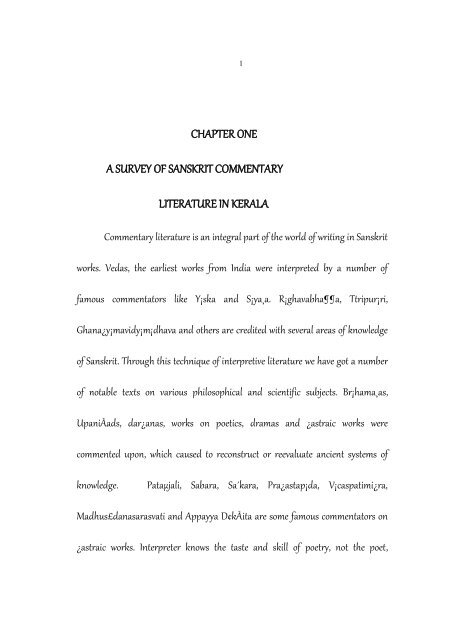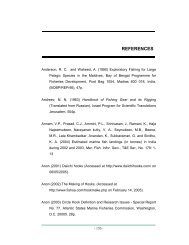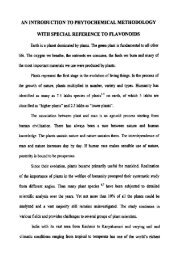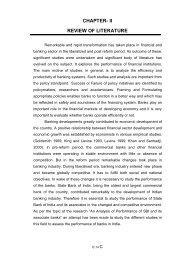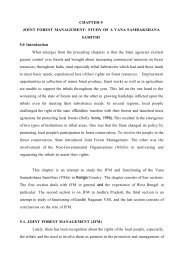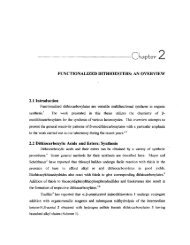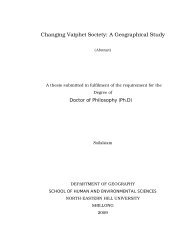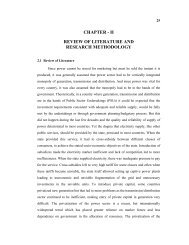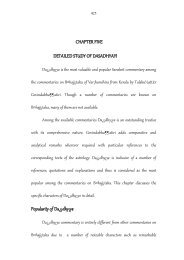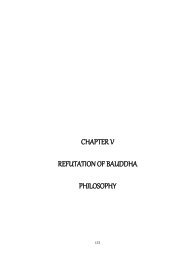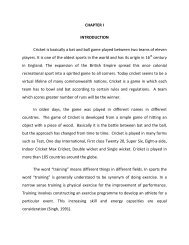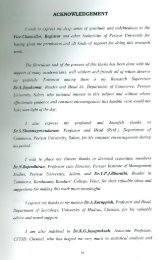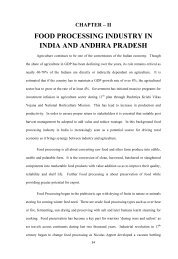chapter one a survey of sanskrit commentary literature in kerala
chapter one a survey of sanskrit commentary literature in kerala
chapter one a survey of sanskrit commentary literature in kerala
You also want an ePaper? Increase the reach of your titles
YUMPU automatically turns print PDFs into web optimized ePapers that Google loves.
1CHAPTER ONEA SURVEY OF SANSKRIT COMMENTARYLITERATURE IN KERALACommentary <strong>literature</strong> is an <strong>in</strong>tegral part <strong>of</strong> the world <strong>of</strong> writ<strong>in</strong>g <strong>in</strong> Sanskritworks. Vedas, the earliest works from India were <strong>in</strong>terpreted by a number <strong>of</strong>famous commentators like Y¡ska and S¡ya¸a. R¡ghavabhaa, Ttripur¡ri,Ghana¿y¡mavidy¡m¡dhava and others are credited with several areas <strong>of</strong> knowledge<strong>of</strong> Sanskrit. Through this technique <strong>of</strong> <strong>in</strong>terpretive <strong>literature</strong> we have got a number<strong>of</strong> notable texts on various philosophical and scientific subjects. Br¡hama¸as,UpaniÀads, dar¿anas, works on poetics, dramas and ¿astraic works werecommented upon, which caused to reconstruct or reevaluate ancient systems <strong>of</strong>knowledge. Pataµjali, Sabara, Sa´kara, Pra¿astap¡da, V¡caspatimi¿ra,Madhus£danasarasvati and Appayya D¢kÀita are some famous commentators on¿astraic works. Interpreter knows the taste and skill <strong>of</strong> poetry, not the poet,
2‘EòÊ´ÉiÉÉ®úºÉSÉÉiÉÖªÉÈ ´ªÉÉJªÉÉiÉÉ ´ÉäÊkÉ xÉÉä EòÊ´É&’. The sense <strong>of</strong> thetext is revealed through <strong>in</strong>terpretations.Kerala’s contribution towards Sanskrit studies is unique. Besides writ<strong>in</strong>gorig<strong>in</strong>al compositions, Kerala writers have written excellent commentaries onstandard works. Sa´kar¡c¡rya may be considered as the most notable scholarsamong the commentators. Even dur<strong>in</strong>g the early centuries <strong>of</strong> the Christian era, thepeople<strong>of</strong>
3Kerala had shown keen <strong>in</strong>terest <strong>in</strong> the study <strong>of</strong> Sanskrit enthusiastically, and fromthe eighth century AD, almost all branches <strong>of</strong> <strong>literature</strong> were attracted the m<strong>in</strong>ds <strong>of</strong>Sanskrit scholars <strong>of</strong> Kerala.Mention may be made <strong>of</strong> outstand<strong>in</strong>g works and commentaries onastronomy, astrology, tantra, stotra, k¡vya, drama, and the like, which are thevaluable contribution <strong>of</strong> Kerala to Sanskrit studies. P£r¸asarasvati, Aru¸agir<strong>in</strong>¡tha,Gov<strong>in</strong>dabhaatiri <strong>of</strong> Talakku½att£r, Abhir¡ma and R¡ghav¡nanda are famousancient commentators on excellent Sanskrit works. This <strong>chapter</strong> deals with theSanskrit commentarial <strong>literature</strong> <strong>of</strong> Kerala to some extent.Orig<strong>in</strong> and development <strong>of</strong> hermeneuticsHermeneutics or vy¡khy¡na¿¡stra is very old <strong>one</strong> <strong>in</strong> India. Many scholarsargue that the vy¡khy¡na¿¡stra was orig<strong>in</strong>ated <strong>in</strong> India and some others say it is <strong>in</strong>abroad. K. Maheswaran Nair refers: “hermeneutics orig<strong>in</strong>ated <strong>in</strong> Europe <strong>in</strong> theHellenic period <strong>in</strong> connection with the study <strong>of</strong> and analysis <strong>of</strong> classical texts, like
4those <strong>of</strong> Homer 1 ”. The pr<strong>in</strong>ciples <strong>of</strong> Hermeneutics were rampant <strong>in</strong> India from thevery early period. Accord<strong>in</strong>g to Indian scholars, <strong>commentary</strong> could be manifold. Ingeneral it is called bh¡Àya, ¢k¡, vivrti, vivara¸¡, vy¡khy¡na, vy¡khy¡, nibandha,which are considered synonyms. But each <strong>of</strong> these names is technically differentaccord<strong>in</strong>g to the nature <strong>of</strong> <strong>in</strong>terpretation. Ma<strong>in</strong>ly these are used to teach disciples <strong>in</strong>simple method. Rgvedapr¡ti¿¡khy¡ (15-9) refers to the method <strong>of</strong> teach<strong>in</strong>g Vedas as:MÉÖ¯û& ÊɹªÉºªÉ {Énù¨Éɽþ ¨ÉÖJªÉÆ ºÉ¨ÉɺÉSÉänùºÉ¨ÉɺÉÉä ªÉÊnùuäù *BiÉäxÉ Eò±{ÉäxÉ ºÉ¨ÉÉ{ªÉ |ÉxÉÆ |ÉiªÉ¨xÉɪÉÖºiÉnÂù {ÉÖxÉ®äú´É ºÉ´Éæ ** 1This verse provides some light on the ancient form <strong>of</strong> <strong>in</strong>terpretation. In Ny¡yako¿a 2 ,‘¢k¡’ is def<strong>in</strong>ed as follows: ‘¨ÉÚ±ÉOÉxlɺªÉ+|ÉÊiÉ{ÉÊkÉÊ´É|ÉÊiÉ{ÉkªÉxªÉlÉÉ|ÉÊiÉ{ÉÊkÉÊxÉ´ÉÉ®úhÉäxÉiÉiEòiÉÖÇ®úʦÉ|ÉäiɺªÉ ɤnùÉxiÉ®äúhÉ Ê´É´É®úhÉÆ ]õÒEòÉ *’1Ed. P.C Muraleemadhavan, Indian theories <strong>of</strong> Hermeneutics, (article) entitled Historicity <strong>of</strong> Vedic Exegesis,by K. Maheswaran Nair New Bharatiya Book Corporation, NewDelhi, 2002, p.3321( Article) The commentarial <strong>literature</strong> <strong>in</strong> Sanskrit, by N.V.P. Unithiri, Journal <strong>of</strong> Kerala studies, ed.T.K.Raveendran, vol. x, 1983, p. 1572vy¡khy¡na¿¡stram <strong>of</strong> C.Rajendran, (Mal), Keralabhasha Institute, Thiruvananthapuram, 2005, p.9(Ny¡yako¿a, p.306),
5The word ¢k¡ can be derived from the root ‘¢k’ mean<strong>in</strong>g ‘to move’ ‘to go’etc ‘]õÒCªÉiÉä MɨªÉiÉä OÉxlÉÉlÉÉæ +xɪÉÉ
6In Mah¡bh¡Àya 1 Pataµjali def<strong>in</strong>es vy¡khy¡na as ‘xÉ Eäò´É±ÉÆSÉSSÉÉÇ{ÉnùÉÊxÉ ´ªÉÉJªÉÉxÉÆ ´ÉÞnÂùvªÉiÉä
7={ÉÉänÂùPÉÉiÉ{ÉnÆù SÉè´É {ÉnùÉlÉÇ&{ÉnùÊ´ÉOɽþ&*SÉɱÉxÉÉ |ÉiªÉ´ÉºlÉÉ SÉ ¹ÉÉäføÉ´ªÉÉJªÉÉxɱÉIÉhɨÉÂ** 3From the above menti<strong>one</strong>d references about commentaries it is clear that<strong>commentary</strong> <strong>literature</strong> occupies a notable position <strong>in</strong> Sanskrit from the ancienttime. In later time many m<strong>in</strong>ute differences were discussed about the technicalterms <strong>in</strong> commentaries. Moreover viv¤ti, v¡rtik¡, bh¡Àya and k¡rik¡ were generallywritten only <strong>in</strong> the field <strong>of</strong> ¿¡straic <strong>literature</strong>. As far as general <strong>literature</strong> isconcerned, ¢k¡ or vy¡khy¡naand ippa¸i are the relevant forms <strong>of</strong> commentaries.P¡hya also is a term to denote a form <strong>of</strong> <strong>commentary</strong>.The Nirukta and various Br¡Åma¸as may be considered as the detailedteach<strong>in</strong>g notes. Sa´kar¡c¡rya agrees that <strong>one</strong> <strong>of</strong> the eight3Vatakkumkur, K.S.S.C, vol.I, Sree Sankaracharya University <strong>of</strong> Sanskrit,Kalady, 1997 p.511
8divisions <strong>of</strong> the Br¡Åma¸a as vy¡khy¡na is the means <strong>of</strong> <strong>in</strong>terpretation <strong>of</strong> the hymns:‘¨ÉxjÉÊ´É´É®úhÉÆ ´ªÉÉJªÉÉxÉÉÊxÉ* 1 ’As the Vedic <strong>literature</strong> became more and more ambiguious <strong>in</strong> the latertimes, the six ved¡´gas developed through oral teach<strong>in</strong>g. Later on theseweredocumented as written works and the learn<strong>in</strong>g <strong>of</strong> these by heart became moredifficult. Then developed a system <strong>of</strong> s£tra <strong>literature</strong> where ideas are arranged <strong>in</strong>too brevity. Subsequently all the systems <strong>of</strong> philosophy came to be recorded <strong>in</strong> thesutra form, which is highly useful to grasp word<strong>in</strong>gs and to recollect easily. JamesMill, the author <strong>of</strong> ‘The History <strong>of</strong> British India’ observes: “all their (<strong>of</strong> the Indians)compositions, with wonderfully few exceptions <strong>in</strong> general, are <strong>in</strong> verse. Their sacredbooks, and even their books <strong>of</strong> sciences, are <strong>in</strong> verse; and what is more wonderfulstill, their very Dictionaries 2 ”. N.V.P. Unithiri observes it as “The method <strong>of</strong> oralteach<strong>in</strong>g through question and answer and subsequent discussions was revived. Incourse <strong>of</strong> time, this oral tradition had also to be put <strong>in</strong> writ<strong>in</strong>g. Thus came <strong>in</strong>to1B¤had¡ra¸yakabh¡Àya, 2-4-102James Mill, The History <strong>of</strong> British India, vol.I, Associated publish<strong>in</strong>g house,New Delhi, 1972 (IInd ed, repr<strong>in</strong>t), Pp.365-66.
9existence the different types <strong>of</strong> commentaries such as v¤tti, v¡rtik¡, bh¡Àya, ¢k¡,viv¤ti vy¡khy¡na and the like 3 ”.A brief <strong>survey</strong> <strong>of</strong> commentators and commentaries on Sanskrit works <strong>in</strong>India especially related to Kerala on various systems <strong>of</strong> philosophy is given <strong>in</strong> thefollow<strong>in</strong>g pages.3Op.Cit., ( article) The commentarial <strong>literature</strong> <strong>in</strong> Sanskrit, by N.V.P. Unithiri, p. 158
10Comentators on Vedic TextsThe verse <strong>of</strong> Mah¡bh¡rata (1-1-204) ‘
11he has commented upon the fifth s£kta <strong>of</strong> tenth ma¸·ala <strong>of</strong> Rgveda. N¡r¡ya¸¡c¡ryamay be a contemporary <strong>of</strong> Skandasv¡m<strong>in</strong>.Hast¡malaka, the disciple <strong>of</strong> great philosopher Sa´kara was a commentator<strong>of</strong> Vedas. But the <strong>commentary</strong> is not available. Ve´kaam¡dhava (11 th century AD),another commentator on Rgveda lived <strong>in</strong> the village namely Gomana near riverK¡ver¢. His <strong>commentary</strong>
12known as Rgarthad¢pik¡ is available. LakÀma¸¡c¡rya (12 thcentury AD),DhanuÀkayajvan commented Rk, Yajus, S¡ma vedas and Anandat¢rtha (1255-1335AD) also commented on Rgveda. Atm¡nandat¢rtha (13 th century AD) is also anRgvedic commentator, who commented only forty ¿lokas <strong>of</strong> tenth ma¸·ala.Another famous commentator S¡ya¸¡c¡rya, commented four Vedas <strong>in</strong> detail.R¡va¸a, Mudgal¡c¡rya, (15 th century AD) Devasv¡mi, Bhaabh¡skara Guh¡deva,Durg¡c¡rya (15 th century AD), Uvvaa, Mah¢dhara etc are famous among them.Bhaasv¡mi’s <strong>commentary</strong> on Taittar¢yasaÆhit¡ is not presently available.Commentaries on Dar¿anasSix systems <strong>of</strong> orthodox philosophy namely s¡´khya, yoga, ny¡ya, vai¿eÀika,p£rvam¢m¡Æsa and uttaram¢m¡Æsa were came <strong>in</strong>to existence first <strong>in</strong> the form <strong>of</strong>s£tras. They were also followed by numerous bh¡Àya or commentaries on them. It isdifficult to ascerta<strong>in</strong> the chronological order <strong>of</strong> the s£tras as well as that <strong>of</strong> thebh¡Àyas.Sa´kar¡c¡rya <strong>in</strong> his BraÅmas£trabh¡Àya mentions the name <strong>of</strong>Sabarasv¡m<strong>in</strong> as a commentator <strong>of</strong> m¢m¡Æsa. R¡m¡nuja mentions that there was a
13v¤tti on the BraÅmas£tra by Bodh¡yana before Sa´kara. We have some pro<strong>of</strong>s thatthe bh¡Àyas were written when there were other v¤ttis or short explanations <strong>of</strong> thes£tras. K¡lid¡sabha¡c¡rya mentions that “the Gau·ap¡dak¡rik¡1<strong>of</strong> the1Ed.Ramasvami iyer, Cultural Heritage <strong>of</strong> India, vol. V, The Ramakrishnamission Institute <strong>of</strong> Culture.1993,p.372
14M¡¸·£kyopaniÀad was written <strong>in</strong> the form <strong>of</strong> k¡rik¡s or short verses”.S¡´khyadar¿ana <strong>of</strong> KapilaS¡´khyadar¿ana is probably the oldest <strong>one</strong> <strong>in</strong> our traditional schools <strong>of</strong>philosophy. Though Kapila is universally recognized as the founder <strong>of</strong> s¡´khyasystem, the S¡´khyas£tra that is available is not very old. But the first systematicwork on s¡´khya is supposed to be I¿varak¤À¸a’s (3 rd century AD) S¡´khyak¡rik¡. Anumber <strong>of</strong> commentaries are available on it. Recently a very old <strong>commentary</strong> on itnamed Yuktid¢pik¡ by an unknown writer has been published 1 .Gau·ap¡da (7 th century AD) wrote a <strong>commentary</strong> on S¡´khyak¡rik¡ calledGaudap¡dabh¡Àya. In the n<strong>in</strong>th century AD a <strong>commentary</strong> by V¡caspatimi¿ra,known as Tatvakaumud¢, which is the most popular work, was composed.Sa´kar¡c¡rya’s (8 th century AD) Jayama´ga½a, V¡caspatimi¿ra’sTatvakaumud¢, Aniruddha’s (15 th century A D) Aniruddhav¤tti, Vijµ¡nabhikÀu’s(17 th century AD) S¡´khyapravacanabh¡Àya, N¡r¡ya¸at¢rtha’s (17 th century AD)Candrik¡, VaÆ¿¢dharami¿ra’s (17 th century AD) S¡´khyatatvavibh¡kara and1Ed.by Gerald James Larson and Ramshankar Bhattacharya, Encyclopedia <strong>of</strong> Indian Philosophies, MotilalBanarsidass, New Delhi, 1987
15K¤Àa¸avallabh¡c¡rya’s Kira¸a are the popular commentaries on s¡´khya. Gu¸aratna(14 th century AD)
16and Mah¡deva¿¡stri (17 th century AD) commented s¡´khya but their works are notpresently available.Yogadar¿anaThe yoga system <strong>of</strong> Pataµjali is a meta-psychological technique based uponthe philosophy <strong>of</strong> the s¡´khya. As a system <strong>of</strong> practice it is as old as the Atharvavedaand some earlier upaniÀads. The Mah¡bh¡rata the Bhagavadg¢t¡ and Lalitavist¡raalso refer to Yogic practices. The <strong>literature</strong> on yoga is thus found <strong>in</strong> an unsystematicform extensively <strong>in</strong> ancient Indian works.The first systematic work on yoga,however, is Pataµjali’s Yogas£tra. Vy¡sa’s (6 th century AD) Yogabh¡Ày¡ or V¡rtik¡ isan elaborate <strong>commentary</strong> on it.V¡caspatimi¿ra’s Tatvavai¿¡rad¢ and Vjµ¡nabhikÀu’s Yogav¡rtika are thetwo famous commentaries on Vy¡sa’s bh¡Àya. Bhoja has also written a small<strong>commentary</strong> not so much on Vy¡sa’s bh¡Àya as on the Yogas£tra itself, known asBhojav¤tti otherwise known as R¡jam¡rt¡¸·a. K¤À¸avallabh¡c¡rya’s Kira¸a is another<strong>commentary</strong> on it. Other commentaries on Yogas£tra are Ga¸e¿a D¢kÀita’s V¤tti,R¡m¡nandasarasvati’s (7 th century AD) Ma¸iprabh¡, N¡r¡ya¸at¢rtha’s
17Yogasiddh¡ntacandrik¡, and S£tr¡rthabodh<strong>in</strong>¢, N¡ge¿abhaa’s (18 th century AD)Ch¡y¡vy¡khy¡, Sad¡¿iva’s (18 thcentury AD) Yogasudh¡kara, Anandapa¸·ita’sCandrik¡, Baladevami¿ra’s Yogaprad¢pik¡ and
18Vijµ¡nabhikÀu’s Yogas¡ra. Thus like other systems, yoga texts have a good number<strong>of</strong> commentaries.Vai¿eÀikadar¿anaVai¿eÀika philosophy, known as Aul£kyadar¿ana, is formulated <strong>in</strong> theVai¿eÀikas£tra <strong>of</strong> Ka¸¡da who belonged to a very ancient age. Vai¿eÀikas£traemphasized more <strong>in</strong> metaphysics than <strong>in</strong> logic and theory <strong>of</strong> knowledge. It beg<strong>in</strong>swith propos<strong>in</strong>g the task <strong>of</strong> expla<strong>in</strong><strong>in</strong>g ‘dharma’ and ends with referr<strong>in</strong>g to theefficacy <strong>of</strong> Vedic <strong>in</strong>junctions. The contributions <strong>of</strong> vai¿eÀikas are more popular andmaterialistic. The earliest <strong>commentary</strong> on Vai¿eÀikas£tra is Bharadv¡jav¤tti andR¡va¸abh¡Àya. They are however no longer extant. One has now to rely chiefly onsuch treatises as Up¡skara by Sa´karami¿ra (15 th century AD) and Ka¸¡das£trav¤ttiby Jayan¡r¡ya¸atarkkapaµc¡nana (19 th century AD). There is also a detailed<strong>commentary</strong> on Up¡skara called PariÀk¡ra composed recently by Paµc¡nana.Vyoma¿iv¡c¡rya’s (10 th century AD) Vyom¡vat¢ is the <strong>commentary</strong> onPad¡rthadharmasa´graha on the vai¿eÀika system. This was followed by
19Sr¢dhar¡c¡rya’s (10 th century AD) Ny¡yakandal¢, which was commented upon byR¡ja¿ekhara (12 th century AD) <strong>in</strong> his Ny¡yakandal¢paµcik¡.Udayana (12 th century AD) wrote LakÀa¸¡val¢ which is a short manual <strong>of</strong>Vai¿eÀika. Other major works <strong>of</strong> Udayana are:
20Ny¡yakusum¡µjal¢ on Ny¡yavai¿eÀika and Atmatatvaviveka a work <strong>in</strong> which theNy¡yavai¿eÀika concept <strong>of</strong> the self has been elaborated and LakÀa¸am¡l¡. Anumber <strong>of</strong> commentaries are available on Udayana’s works. Sa´karami¿ra’sKalpalat¡ on Udayana’s Atmatatvaviveka is very popular.Ny¡yadar¿anaThe philosophy <strong>of</strong> ny¡ya from the ancient days to the beg<strong>in</strong>n<strong>in</strong>g <strong>of</strong> thethirteenth century was as much on the theory <strong>of</strong> knowledge as on constructivemetaphysics. The first systematic work on ny¡ya is the Ny¡yas£tra <strong>of</strong> Gautama(AkÀap¡da) supposed to have been composed <strong>in</strong> the third century BC. The earliest<strong>commentary</strong> on it written before the fifth century AD is by V¡tsy¡yana and is knownas V¡tsy¡yanabh¡Àya. Udyotakara (6 th century AD) wrote a <strong>commentary</strong> on thisbh¡Àya known as Ny¡yav¡rtik¡.V¡caspatimi¿ra (9 thcentury AD) wrote a <strong>commentary</strong> on Udyotakara’sNy¡yav¡rtik¡ an expository treatise known as Ny¡yav¡rtikat¡tparya¢k¡.V¡caspatimi¿ra was a multi faceted scholar who wrote a number <strong>of</strong> commentaries
21on different systems <strong>of</strong> philosophy namely ny¡ya, advaitaved¡nta, s¡´khya, yoga andm¢m¡Æsa.Among the ny¡ya commentaries Vardham¡na’s (13 thcentury AD)Ny¡yapari¿iÀhaprak¡¿a on Udayana’s Ny¡yapari¿iÀha, Jayantabhaa’sN»¡yamaµjar¢ (9 th century AD), Vardham¡na’s
22(13 th century AD) Anv¢kÀ¡ny¡yatatvabodha and some ten commentaries entitledPrak¡¿a on different topics, are famous. Jayadevami¿ra, author <strong>of</strong> Many¡loka wroteseveral commentaries on Vardham¡na’s works. Thus numerous commentaries areavailable by famous scholars on ny¡ya philosophy.P£rvam¢m¡ÆsaP£rvam¢m¡Æsa is a system <strong>of</strong> philosophy, which deals with the nature <strong>of</strong>dharma as propounded <strong>in</strong> the karmak¡¸·a <strong>of</strong> the Vedas. This system diverted itself<strong>in</strong>to two ma<strong>in</strong> schools, namely that <strong>of</strong> Kum¡rilabhaa (7 th century AD) and that<strong>of</strong> his disciple Pr¡bh¡karami¿ra to which was added a third viz. that <strong>of</strong> Mur¡ri.Jaim<strong>in</strong>i’s M¢m¡Æsas£tra (400 BC) forms the foundation <strong>of</strong> m¢m¡Æsa philosophy.M¢m¡Æsas£tras were commented on by UpavarÀa and later bySabarasv¡m<strong>in</strong>. The earliest available <strong>commentary</strong> on M¢m¡Æsas£tra isSabarasvam<strong>in</strong>’s Sabarabh¡Àya. There were other commentaries before him.Bhart¤mitra referred to <strong>in</strong> Ny¡yaratn¡kara, Slokav¡rtika, Bhavad¡sa is also
23referred to <strong>in</strong> Slokav¡rtika. Keith also refers the name <strong>of</strong> UpavarÀa, commentatorwho must have flourished before Sabarasv¡m<strong>in</strong> 1 .Sabarabh¡Àya had commented upon by Kum¡rilabhaa <strong>in</strong> hisSlokav¡rtika, Tantrav¡rtika and Tup-¢ka and also <strong>in</strong> his B¤hat¢ka andMadhyama¢ka. Based on Sabarabh¡Àya,1A. Berried ails Keith, A History <strong>of</strong> Sanskrit <strong>literature</strong>, Motilal Benarsidass, New Delhi, 1996, p.473
24Prabh¡kara who formed a different school wrote two <strong>in</strong>dependent commentariesB¤hati (nibandha), and Laghvi (Vivara¸a). These are aga<strong>in</strong> commented upon byS¡lik¡n¡tha <strong>in</strong> Rjuvimala and Paµcik¡ elucidat<strong>in</strong>g Prabh¡kara’s <strong>in</strong>terpretation <strong>of</strong>m¢m¡Æsa. Ma¸·anami¿ra (8 th century AD) who eventually accepted Vedantismunder the <strong>in</strong>fluence <strong>of</strong> Sa´kara and Bhaomveka were also Kum¡rila’s disciples.The former wrote Vidhiviveka, Bh¡van¡viveka and M¢m¡Æs¡nukrama¸¢ while thelater composed commentaries on Slokav¡rtika and Bh¡van¡viveka.P¡rthas¡rathimi¿ra (9 th century AD) wrote S¡strad¢pik¡, Tantraratna andNy¡yaratnam¡l¡ <strong>in</strong> support <strong>of</strong> Kum¡rila’s <strong>in</strong>terpretation <strong>of</strong> m¢m¡Æs¡. Among thefollowers <strong>of</strong> Kumarila, the most em<strong>in</strong>ent are Sucaritami¿ra author <strong>of</strong> K¡¿ik¡ andBhaasome¿vara author <strong>of</strong> Ny¡yasudha. R¡mak¤À¸a’s <strong>commentary</strong> on theS¡strad¢pik¡ <strong>of</strong> Tarkap¡da called Yuktisnehaprap£ra¸¢siddhantacandrik¡ andSoman¡tha’s <strong>commentary</strong> on the rema<strong>in</strong><strong>in</strong>g <strong>chapter</strong>s <strong>of</strong> S¡strad¢pik¡ known asMay£kham¡lik¡ are held to be important contribution to m¢m¡Æs¡dar¿ana.ParitoÀami¿ra’s Ajit¡ is a competent <strong>commentary</strong> on Tantravartika.Other important works on P£ravam¢m¡Æsa are Ny¡yam¡l¡vist¡ra <strong>of</strong> M¡dhava,
25Ny¡yaka¸ik¡ <strong>of</strong> V¡caspatimi¿ra, M¢m¡Æs¡paribh¡Àa <strong>of</strong> K¤Àa¸ayajvan,M¢m¡Æs¡ny¡yaprak¡¿a
26<strong>of</strong> Apadeva, Subodh<strong>in</strong>¢ <strong>of</strong> G¡g¡bhaa and M¢m¡Æs¡b¡laprak¡¿a etc.Appayyad¢kÀita’s (1520 AD) Vidhiras¡yana and May£kh¡val¢ (a<strong>commentary</strong> on S¡strad¢pik¡). Ve´kae¿varad¢kÀita’s V¡rtik¡bhara¸a (a<strong>commentary</strong> on Tup-¢k¡), Kha¸·adeva’s Bhaakaustubha, Bhaad¢pik¡ andBhaarahasya, and M¡nameyodaya <strong>of</strong> N¡r¡ya¸abhaa, Sa´karabhaa’sSiddhiras¡yanad£Àa¸a, Ve´kaan¡tha’s M¢m¡Æs¡p¡duk¡, Laug¡kÀibh¡skara’sArthasa´graha, Vallabh¡c¡rya’s P£rvam¢m¡Æs¡k¡rik¡ Bhavan¡tha’s Ny¡yavivekaand R¡m¡nuj¡c¡rya’s Tantrarahasya are famous works and commentaries onm¢m¡Æsa school.Uttaram¢m¡Æs¡ or Ved¡ntaUttaram¢m¡Æs¡ exam<strong>in</strong>es the nature <strong>of</strong> BraÅman or reality beh<strong>in</strong>d themortal world. A vast <strong>literature</strong> is available <strong>in</strong> the form <strong>of</strong> commentaries on theUpaniÀads, Bhagavadg¢t¡ and Brahmas£tra which have been written from thestandpo<strong>in</strong>ts <strong>of</strong> Advaita, Vi¿iÀ¡dvaita, Dvaita, Dvait¡dvaita, Suddh¡dvaita,Ac<strong>in</strong>tyabhed¡bhed¡dvaita etc. It may be assumed that the first ancient systematic
27commentaries on Ved¡nta are that <strong>of</strong> Sa´kara, great advaita philosopher (8 thcentury AD).So many commentaries are available <strong>in</strong> Ved¡ntic field. The chief schools <strong>of</strong><strong>in</strong>terpretations are the advaita expounded first by
28Gau·ap¡da and followed by Sa´kara, the Vi¿iÀh¡dvaita by R¡m¡nuja, the Dvaita<strong>of</strong> M¡dhva, the Dvait¡dvaita <strong>of</strong> Nimb¡rka, the Suddh¡dvaita <strong>of</strong> Vallabha and theAc<strong>in</strong>tyabhed¡bhed¡dvaita by Sr¢caitanya, all are establish<strong>in</strong>g their norms <strong>in</strong>different criteria <strong>of</strong> truth and relay<strong>in</strong>g upon different sources <strong>of</strong> valid knowledgeand the commentators arrived at different conclusions.Sa´kara and <strong>commentary</strong> <strong>literature</strong>Dr.E.Isvaran Namputiri observes: “There is no name <strong>in</strong> the history <strong>of</strong>Indian philosophy which is more honoured and <strong>in</strong>spir<strong>in</strong>g than that <strong>of</strong> Sa´kara, thegreatest philosopher <strong>of</strong> the world… 1 ” Of Sa´kara’s works, bh¡Àya on theBraÅmas£tra is the most important <strong>one</strong>, which is acclaimed as a masterpiece notonly for its acute logical analysis but also for its graceful style. His other importantworks are the commentaries on the pr<strong>in</strong>cipal UpaniÀads such as Kena, Kaha,Pra¿na, Mu¸·a, M¡¸·£kya, Aitareya, Taitar¢ya, Ch¡ndogya and B¤had¡ra¸yaka.1 Ved¡ntapaddhati,ed.Isvaran Namputiri,Keralasamskrtam Publications, Thiruvananthapuram,1996, p.3
29Sa´kara’s bh¡Àya on the Bhagavadg¢t¡ is also a classic. Besides,ViÀ¸usahasran¡mabh¡Àya, Sanatsuj¡t¢yabh¡Àya, Hast¡malakabh¡Àya,Lalitatri¿at¢bh¡Àya, Vivekac£·¡ma¸i, Upade¿as¡hasr¢, Paµc¢kara¸aprakriy¡,AparokÀ¡nubh£ti, Sarvaved¡ntas¡rasa´graha, V¡kyasudh¡, D¤gd¤¿yaviveka,Prapaµcas¡ra, Atmabodha etc are also attributed to him.
30Sa´kara’s BraÅmas£trabh¡Àya has served as a basic document for furthercommentaries and sub commentaries <strong>of</strong> great philosophic <strong>in</strong>sight and logicalthroughness. Some <strong>of</strong> them are noted below:Anandagiri wrote a <strong>commentary</strong> called Ny¡yanir¸aya, while Gov<strong>in</strong>d¡nanda(16 th CenturyAD) wrote another <strong>one</strong> known as Ratnaprabh¡. V¡caspatimi¿ra wrotea <strong>commentary</strong> on Sa´kara’s bh¡À»a known as Bh¡mat¢. On it Amal¡nanda (13 thcentury AD) wrote his Kalpataru which is commented upon by Appayyad¢kÀita<strong>in</strong> his Kalpataruparima½a.Padmap¡da another disciple <strong>of</strong> Sa´kara wrote a <strong>commentary</strong> known asPaµcap¡dik¡ deal<strong>in</strong>g with the first four sutras. Sure¿var¡c¡rya wroteNaiÀkarmmasiddhi, which is partly <strong>in</strong> prose and partly <strong>in</strong> verse and consists <strong>of</strong>four <strong>chapter</strong>s expos<strong>in</strong>g the nature <strong>of</strong> avidy¡. Jµ¡nottamami¿ra’s T¢k¡ calledBh¡vatatvaprak¡¿ik¡ is well known exposition <strong>of</strong> NaiÀkarmmasiddhi. Its othersubcommentaries are Jµ¡n¡m¤ta’s Vidy¡surabhi, Akhil¡tman’sNaiÀkarmmasiddhivivara¸a and R¡madatta’s S¡r¡rtha. Prak¡¿¡tman wrote a<strong>commentary</strong> on Paµcap¡dik¡ known as Paµcap¡dik¡vivara¸a which has two
31commentaries Tatvad¢pana <strong>of</strong> Akha¸·¡nanda and Vivara¸abh¡vaprak¡¿ik¡ byN¤siÆha¿armamuni (1500 AD). Amal¡nanda and Vidy¡s¡gara also wrotecommentaries on Paµcap¡dik¡ named Paµcap¡dik¡darpa¸a and Paµcap¡dik¡¢k¡respectively. Vidy¡ra¸ya (1350 AD) elucidated and expanded the teach<strong>in</strong>gs <strong>of</strong>Paµcap¡dik¡vivara¸a <strong>in</strong> his Vivara¸aprameyasa´graha.Sarvajµ¡tmamuni (900 AD) wrote SaÆkÀepa¿ar¢rik¡ based on theteach<strong>in</strong>g <strong>of</strong> Sa´kara’s bh¡Àya. Citsukha had also written an <strong>in</strong>dependent work onVed¡nta dialectics known as Tatvad¢pik¡, which was commented upon byPratyagr£pa <strong>in</strong> his Nayanapras¡d<strong>in</strong>¢. Dharmar¡j¡dhvar¢ndra’s (1550 AD)Ved¡ntaparibh¡À¡ is a celebrated work on ved¡nta which was commented upon byhis son R¡mak¤À¸¡dhvar¢ndra <strong>in</strong> his SikÀ¡ma¸¢ and by Amarad¡sa <strong>in</strong> hisMa¸iprabh¡.Madhus£danasarasvati (16 th century AD) wrote his Advaitasiddhi whichis regarded as a comprehensive treatise on Advaitaved¡nta. His other importantworks are G¢t¡g£·h¡rthad¢pik¡ (a <strong>commentary</strong> on Bhagavadg¢t¡),
32Prasth¡nabheda, AdvaitaratnarakÀa¸a, Nirv¡¸ada¿aka¢k¡, Vedastuti¢k¡,Atmabodha¢k¡ etc.Other notable works on Advaita <strong>in</strong>clude Anandabodhabha¡kar¡c¡rya’s(12 th century AD) Ny¡yamakaranda, Sad¡nandagov<strong>in</strong>da’s (16 th century AD)Ved¡ntas¡ra, (It has two commentaries Subodh<strong>in</strong>¢ and Vidvanmanoraµj<strong>in</strong>¢),Prak¡¿¡nanda’s (16 th century AD) Ved¡ntasiddh¡ntamukt¡val¢, andK¡¿m¢rakasad¡nandayati’s (18 th century AD) AdvaitabraÅmasiddhi.
33Sanskrit <strong>commentary</strong> <strong>literature</strong> <strong>of</strong> KeralaKerala has contributed pr<strong>of</strong>usely on Poetics, Dramaturgy, ¡yurveda, andjyotiÀa both orig<strong>in</strong>al works and commentaries. Many works <strong>of</strong> skilled scholarscaused for significant orig<strong>in</strong>al works, come down through the detailedcommentaries. Kerala has noted for a long and cont<strong>in</strong>uous tradition <strong>of</strong> Sanskritlearn<strong>in</strong>g. In addition to k¡vya, n¡aka, ala´k¡ra, studies comprised the Vedas andved¡´gas and a number <strong>of</strong> other ¿¡stras like the dar¿anas, tantra, ¿ilpa, ¡yurveda,jyotiÀa etc. The vast literary outputs as well as the pr<strong>of</strong>ound learn<strong>in</strong>g displayed <strong>in</strong>most <strong>of</strong> the works particularly those are <strong>in</strong> the form <strong>of</strong> commentaries bespeak the<strong>in</strong>tensity <strong>of</strong> the learn<strong>in</strong>g.Sanskrit study, which is associated with Aryan culture, must havecommenced <strong>in</strong> Kerala with the spread <strong>of</strong> this culture here. This culture took root <strong>in</strong>Kerala or <strong>in</strong>fluenced strongly at least from the seventh century AD. Poet Da¸·<strong>in</strong>, <strong>in</strong>the <strong>in</strong>troductory part <strong>of</strong> his Avantisundar¢kath¡, refers to some <strong>of</strong> his friends <strong>of</strong>Kerala who were great teachers and scholars, commentators on Vedic texts andKalpas£tras and performers <strong>of</strong> sacrifices. From this reference it is clear that Vedicreligion was well established <strong>in</strong> Kerala by that time. Kunjunni Raja refers that
34Kula¿ekhara A½v¡r the author <strong>of</strong> Mukundam¡l¡ was a Keralite born atTiruvaµciku½am <strong>in</strong> 3075 BC. 1 The migration <strong>of</strong> Brahm<strong>in</strong>s to Kerala and other part<strong>of</strong> south India formed <strong>in</strong>to a dist<strong>in</strong>ct set <strong>of</strong>f Brahm<strong>in</strong>s called ‘Namputiris’1 K.Kunjunni Raja, Contribution <strong>of</strong> Kerala to Sanskrit Literature (C.K.S.L), University <strong>of</strong> Madrass, 1980, p.1-3
35amalgamat<strong>in</strong>g the customs <strong>of</strong> the different settlers and <strong>in</strong>corporat<strong>in</strong>g some new<strong>one</strong>s result<strong>in</strong>g from the peculiarities <strong>of</strong> environment.Namputiris founded schools for the study <strong>of</strong> Veda and ¿¡stra particularlywith a view <strong>in</strong> produc<strong>in</strong>g scholars to meet arguments aga<strong>in</strong>st the upholders <strong>of</strong>Buddhism and Ja<strong>in</strong>ism, which had considerable hold on the people <strong>in</strong> those days,and reassert the supremacy <strong>of</strong> the Vedic religion. It is believed that Prabh¡karamay be considered as the master <strong>of</strong> <strong>one</strong> <strong>of</strong> these schools, although it has to beremembered that all do not accept the claim for this nativity <strong>of</strong> Prabh¡kara.Venkatasubrahmanya Iyer says <strong>in</strong> his paper entitled ‘Sanskrit studies <strong>in</strong>Kerala-past and present’ that “the Namputiris were close followers <strong>of</strong> Vedictradition and naturally therefore, they had a partiality for a ritualistic philosophy<strong>of</strong> m¢m¡Æsa, with the result that even the great philosophy <strong>of</strong> advaita propoundedby Sa´kara, the greatest son <strong>of</strong> Kerala, did not fasc<strong>in</strong>ate them as much as it did thepeople <strong>in</strong> the rest <strong>of</strong> India 1 ”.1 (Article) Sanskrit studies <strong>in</strong> Kerala-past and present by S.Venkitasubramonia Iyer, Journal <strong>of</strong> Kerala studies,vol.III, ed. T.K. Rav<strong>in</strong>dran, Kerala University, Thiruvananthapuram, p.162 1976.
36Acadamic centres <strong>of</strong> medival <strong>of</strong> KeralaEven dur<strong>in</strong>g the early centuries <strong>of</strong> the Christian era, the people <strong>of</strong> Keralahad taken to the study <strong>of</strong> Sanskrit enthusiastically embrac<strong>in</strong>g almost all branches<strong>of</strong> <strong>literature</strong>. The pr<strong>in</strong>ces and rulers <strong>of</strong> small territories <strong>in</strong> Kerala greatlyencouraged orig<strong>in</strong>al writ<strong>in</strong>g <strong>in</strong> Sanskrit and
37this resulted <strong>in</strong> a great number <strong>of</strong> poets and valuable works and <strong>in</strong>terpretationswere produced on all areas <strong>of</strong> Sanskrit sources.Semi religious educational <strong>in</strong>stitutions called sabh¡mahas wereestablished for the propagation <strong>of</strong> Vedas and ¿¡stras. The mahas at Thrissur andThirunavaya are famous <strong>of</strong> Vedic lore and even now cont<strong>in</strong>ue as centres <strong>of</strong> Vedicstudy. S¡stras were imparted <strong>in</strong> ¿¡strasabh¡mahas. The ma<strong>in</strong> ¿¡stras taught <strong>in</strong>them were Bh¡am¢m¡Æsa, Pr¡bh¡karam¢m¡Æsa, ved¡nta and vy¡kara¸a, eachmaha hav<strong>in</strong>g its own subject <strong>of</strong> specialisation. The mahas at Covvan£r,Iakku½att£r, Kumba½am and Udayatu´ge¿varam were very famous. TheSany¡simahas were connected with the study <strong>of</strong> ved¡nta. There were four <strong>of</strong> themat Thrissur believed to be established by the disciples <strong>of</strong> Sa´kara namelyTekkemaham, Iayilmaham, Nauvilmaham and Vaakkemaham, eachwas headed by a Sany¡s<strong>in</strong>.In addition to these, there were academies associated with some <strong>of</strong> theimportant temples and endowed by the rulers <strong>of</strong> the time. Those were known as
38¿¡l¡s <strong>of</strong> M£½iku½am, Thiruvalla, K¡ntall£r and P¡rthivapuram which werefamous acadamic <strong>in</strong>stitutions. 1Although m¢m¡Æsa, vy¡kara¸a and ved¡nta were taught for <strong>in</strong>tensive andspecialised study, general <strong>literature</strong> and other ¿¡stras were also part <strong>of</strong> thecurriculum. The teachers and scholars <strong>in</strong>terpreted topics <strong>of</strong> <strong>in</strong>terest throughcommentaries for the purpose <strong>of</strong>1 Kera½att<strong>in</strong>te vaidikap¡ramparyam, C.M.Neelakanthan, ‘Anhuruvarshathe<strong>kerala</strong>m chilaviraladayalangal’ ed. V.S. Vargese, Current Books, kottayam, 1999.
39teach<strong>in</strong>g. A number <strong>of</strong> simple works and commentaries had been produced fortheir disciples or academic society. For example, M¡t¤datta <strong>of</strong> Melpatt£r illam, thefather <strong>of</strong> the famous poet and grammarian N¡r¡ya¸a Bhaa was a renownedteacher, and his house was always echo<strong>in</strong>g with ¿¡strap¡has taught to hisdisciples. The work, Dh¡tuk¡vya <strong>of</strong> N¡r¡ya¸abhaa, R¡va¸avadha <strong>of</strong> Bhai,Prakriy¡sarvasva etc, are written <strong>in</strong> the form <strong>of</strong> teach<strong>in</strong>g methodology.Contribution <strong>of</strong> Kerala on various fields <strong>of</strong> knowledge namely m¢m¡Æsa,vy¡kara¸a, jyotiÀa, tantra, ved¡nta, ¡yurveda, poetics and other areas <strong>of</strong> knowledgeare outstand<strong>in</strong>g and thus provide significance <strong>in</strong> the field <strong>of</strong> writ<strong>in</strong>gcommentaries. Mall¢n¡tha, P£r¸asarasvati and Gov<strong>in</strong>dabhaatiri <strong>of</strong>Talakku½att£r were famous commentators.Commentaries on VedaDa¸·<strong>in</strong> (7 thcentury AD) <strong>in</strong>dicates the name <strong>of</strong> M¡t¤datta <strong>in</strong> hisAvantisundar¢kath¡, as his friend who may be the first to be remembered <strong>in</strong>connection with the Vedic commentaries <strong>in</strong> Kerala. He has commented onHira¸yake¿¢¿rautas£tra and Hira¸yake¿¢g¤hyas£tra. Sadguru¿iÀya (12 th century
40AD) renowned commentator <strong>of</strong> the Vedas even before S¡ya¸a, has writtencommentaries MokÀaprada on Aitarey¡ra¸yaka, Sukhaprada onAitareyabr¡Åma¸a, Abhyudayap¡da on A¿val¡yana¿rautas£tra andVidarthad¢pik¡ on Sanaka’s
41Sarv¡nukrama¸¢. A work called Aitarey¡ra¸yakavy¡khy¡ is ascribed to Sa´kara.KauÀ¢takabraÅma¸avy¡khy¡ by Udaya (15 th century AD) is famous <strong>in</strong> this regard.A Padaprad¢pik¡ was written by Vatsyan¡r¡ya¸a (17 thcentury AD)discuss<strong>in</strong>g the Padap¡ha <strong>of</strong> K¤À¸ayaj£rvedatantr¢yasaÆhit¡ which wascommented by the author. It is a valuable addition to Vedic studies <strong>in</strong> Kerala 1 .N¡r¡ya¸a Pa¸·ita was a famous scholar and commentator <strong>of</strong> Kerala, who has writtena number <strong>of</strong> commentaries on Sarv¡nukrama¸ik¡, and vy¡khy¡na <strong>of</strong>Rgvedaparibh¡À¡ 2 .M¢m¡Æs¡ tradition <strong>of</strong> KeralaDr. E. Isvaran Namputiri has said; “for the importance <strong>of</strong> the m¢m¡Æs¡ it issaid that knowledge comprises ma<strong>in</strong>ly eighteen branches, fourteen <strong>of</strong> them<strong>in</strong>strumental to the atta<strong>in</strong>ment <strong>of</strong> dharma and mokÀa and the rema<strong>in</strong><strong>in</strong>g four tothat <strong>of</strong> artha and k¡ma 3 ”1 Padaprad¢pik¡, N.V.P. Unithiri, Mathrubhumi weekend, edi. 22 April. 1984.2Op.Cit., K. S .S.C, vol.I, p.5213Isvaran Namputiri, Glimpses <strong>of</strong> Sanskrit Research (G.S.R), Kerala Samskrita Publication,Thiruvananthapuram, 1995, p.55
42+RÂóMÉÉÊxÉ ´ÉänùÉSÉi´ÉÉ®úÉä ¨ÉÒ¨ÉÉƺÉÉxªÉɪÉʴɺiÉ®ú&*{ÉÖ®úÉhÉÆ vɨÉÇÉɺjÉÆ SÉ Ê´ÉtÉ ÁäiÉÉSÉiÉÖnÇùÉ**Among these fourteen vidy¡s, m¢m¡Æs¡ is an important <strong>one</strong>. South Indiaespecially Kerala had a great tradition <strong>of</strong> the study <strong>of</strong> m¢m¡Æs¡ ¿¡stra. There isanother tradition recorded by Udda¸·a ¿¡stri <strong>in</strong> his Kokilasande¿a regard<strong>in</strong>g the<strong>in</strong>troduction <strong>of</strong> the Bh¡a school <strong>of</strong> m¢m¡Æs¡ <strong>in</strong> Kerala.
43B¹ÉÉÆ ´ÉÆÉä ºÉ¨ÉVÉÊxɽþÊ®úSÉxpùxÉɨÉÉ xÉ®äúxpù&|ÉiªÉÉ{ÉÊkÉ& {ÉiÉMÉ ªÉnÖù{ÉYÉÆ SÉEòÉè¨ÉÉÊ®ú±ÉÉxÉɨÉÂ** 1Bhavad¡sa (2 ndcentury AD) <strong>one</strong> <strong>of</strong> the early commentators onJaim<strong>in</strong>¢yas£tr¡s is believed to be a son <strong>of</strong> Kerala. Accord<strong>in</strong>g to some scholarsKum¡rila and Prabh¡karaguru are believed to be Keralite m¢m¡Æs¡ scholars 2 .Cid¡nanda Pa¸·ita, the author <strong>of</strong> N¢titatv¡virbh¡va and BhaaviÀ¸u the author <strong>of</strong>Ny¡yatatvasa´graha were the two m¢m¡Æs¡ scholars <strong>of</strong> Kerala <strong>of</strong> thirteenth andfourteenth centuries respectively.Parame¿vara I is called ‘m¢m¡Æs¡ cakravart<strong>in</strong>’ by Udda¸·a S¡stri, whoseworks are the Ny¡yasamuccaya and the two commentaries called JuÀadhva´kara¸¢and Svadita´kara¸¢ on the Ny¡yaka¸ik¡ <strong>of</strong> V¡caspatimi¿ra.Parame¿vara II was a great scholar on m¢m¡Æsa and he wrotecommentaries on Ma¸·anami¿ra’s Sphoasiddhi and Vibhramavivek¡,V¡caspatimi¿ra’s Tatvab<strong>in</strong>du and Cid¡nandapa¸·ita’s N¢titatv¡virbh¡va.1Op.Cit., K.S.S.C, vol.I, p.23.2Op.Cit., G.S.R, p.59
44Parame¿vara II is the author <strong>of</strong> the Jaim<strong>in</strong>¢yas£trasa´graha, a valuable<strong>commentary</strong> on the Jaim<strong>in</strong>¢yas£tras. He had a brother V¡sudeva whosecontributions are more literary than scientific.Melputt£r M¡t¤datta, the father <strong>of</strong> Melputt£r N¡r¡ya¸abhaa, was wellversed <strong>in</strong> the school <strong>of</strong> m¢m¡Æs¡ particularly <strong>in</strong> the Bh¡a
45School. Pr<strong>of</strong>. Venkata Subrahmanya Iyer observes that the unpublishedSarvamatasiddh¡ntas¡ra is <strong>in</strong> all probability a work <strong>of</strong> this author 1 . Melputt£rN¡r¡ya¸abhaa was not only a great grammarian and poet but also a famousm¢m¡Æsa scholar. M¡na portion <strong>of</strong> the M¡nameyodaya written by him is a uniquework on m¢m¡Æsa. It deals with the epistemology <strong>of</strong> Bh¡a School.N¡r¡ya¸abhaa also wrote a <strong>commentary</strong> on the Tantrav¡rtik¡ <strong>of</strong> m¢m¡Æsa calledNibandhan¡.Certa<strong>in</strong> other m¢m¡Æs¡ works produced <strong>in</strong> Kerala are referred to by Dr.P.K. Narayanapillai <strong>in</strong> his <strong>in</strong>troduction to the Jaim<strong>in</strong>¢yas£trarthasa´graha. Thoseare Ma´gala¢k¡ on the N¢titatv¡virbh¡va by <strong>one</strong> N¢laka¸ha,Kum¡rilamatopany¡sa written by <strong>one</strong> SubraÅma¸ya, the Prameyapram¡¸a <strong>of</strong>D¡modara, Gurusammatapad¡rtha <strong>of</strong> unknown authorship and theGurumatapad¡rthasa´graha deal<strong>in</strong>g with the eight pad¡rthas <strong>of</strong> Prabh¡kara.A manuscript <strong>of</strong> the work Atharvam¢m¡Æsas£trasa´graha has beenpreserved <strong>in</strong> the Govt. Oriental Manuscript Library. The work is referred to <strong>in</strong> the1 (Article), Melputt£r m¡t¤dattabhaa, Journal <strong>of</strong> Oriental Research, Madras, vol. 28, Pp.62 - 67
46appendix II <strong>of</strong> Tatvab<strong>in</strong>du. This is a lucid <strong>commentary</strong> on theP£rvam¢m¡Æs¡s£tras <strong>of</strong> Jaim<strong>in</strong>i. Accord<strong>in</strong>g to the colophon <strong>of</strong> the manuscripts,the author belongs to Malabar, but his name is not given. The manuscriptconta<strong>in</strong>s the first two <strong>chapter</strong>s
47and first and second adhikara¸as <strong>of</strong> the first p¡da <strong>of</strong> the third adhy¡ya.A <strong>commentary</strong> on the Bh¡van¡viveka <strong>of</strong> Ma¸·anami¿ra calledViÀamagranthabhedik¡ is menti<strong>one</strong>d <strong>in</strong> the triennial catalogue <strong>of</strong> Sanskritmanuscripts 1 . This is written by <strong>one</strong> N¡r¡ya¸a, son <strong>of</strong> ViÀ¸u who may be a Keraliteauthor 2 . It is produced from Koch<strong>in</strong>. This <strong>commentary</strong> is written <strong>in</strong> accordancewith the view <strong>of</strong> Kum¡rila on the M¢m¡Æs¡s£tras <strong>of</strong> Jaim<strong>in</strong>i. The <strong>commentary</strong> is <strong>of</strong>unknown authorship. This work beg<strong>in</strong>s with the salutation <strong>of</strong> Jaim<strong>in</strong>i, B¡dar¡ya¸a,Sabarasv¡m<strong>in</strong> and Sa´kara, hence this work may be written by a Keralite 3 .Da¿¡dhy¡y¢ is another <strong>commentary</strong> <strong>of</strong> the same author. The phrase‘Éä¹É±ÉIÉhɨɴÉÊɹ]õÉxªÉRÂóMɱÉIÉhÉÉÊxÉ +RÂóMɱÉIÉhÉÆ ´ÉÉnùÉÉùvªÉɪªÉÉÆ ´ÉIªÉɨÉ&’ gives the name <strong>of</strong> that <strong>commentary</strong> on m¢m¡Æsa.Adhvaram¢m¡Æs¡s£tr¡rthad¢pik¡ on Jaim<strong>in</strong>¢yas£tra <strong>of</strong> unknown authorship isanother <strong>commentary</strong> on m¢m¡Æsa 4 .1Madras Government Oriental Manuscripts Library, R. No. 306 B2Jaim<strong>in</strong>¢yas£trav¤tti, R. No. 2973 <strong>of</strong> the Triennial Catalogue3Op.Cit., G.S.R, p.604Op.Cit., K.S.S.C, vol.II, p.589.
48So·ha¿¡dhy¡y¢ is a good <strong>commentary</strong> on the sixteen <strong>chapter</strong>s <strong>of</strong>P£rvam¢m¡Æsa and Uttaram¢m¡Æsa. The author whose name is not given andthe work salute Jaim<strong>in</strong>i, Vy¡sa, Sabarasv¡m<strong>in</strong> and Sa´kara.Ny¡yasiddhi is available <strong>in</strong> the form <strong>of</strong> manuscript at Pattambi <strong>in</strong> Palakkaddistrict <strong>of</strong> Kerala. This text is probably written by
49Keralite. It comments on S¡lik¡n¡tha’s Prakara¸apaµcik¡ and is <strong>of</strong> unknownauthorship 1 .M¡naratn¡val¢ is a transcript <strong>of</strong> a manuscript from Koappa·i atMalappuram district <strong>in</strong> Kerala. This is a treatise deal<strong>in</strong>g with metaphysicalstandpo<strong>in</strong>ts <strong>of</strong> the Bh¡a school <strong>of</strong> m¢m¡Æs¡ as aga<strong>in</strong>st Buddha’s, thePr¡bh¡kara’s, the Nayy¡yikas and the M¡y¡v¡d<strong>in</strong>s.From the forego<strong>in</strong>g brief sketch it is evident that the contribution <strong>of</strong> Keralato P£rvam¢m¡Æsa <strong>literature</strong> is remarkable <strong>in</strong> quantity as well as <strong>in</strong> quality.Dharma¿¡straKerala authors have given much attention to the studies <strong>of</strong> Dharma¿¡strasfrom a very remote past. Vararuci’s A¿auc¡Àaka on ceremonial rituals iscommented upon by three anonymous Kerala authors. Their commentaries areknown as Vivara¸a, S£cyagravedhana and Vy¡khy¡. Vatakkumkur quotes a verse<strong>of</strong> A¿auc¡Àaka 2 on A¿auc¡Àaka <strong>of</strong> Vararuci as follows:1Ed. by T.K. Rav<strong>in</strong>dran, vol. X, (article) Sanskrit <strong>in</strong> Kerala <strong>commentary</strong> Litareture, N.V.P.Unithiri, KeralaUniversity, Thiruvananthapuram, 19832Op.Cit., K.S.S.C, vol.II, p.517
50¦ÉMÉ´ÉxiÉÆ ¨ÉxÉÖÆ ªÉÉYɴɱCªÉÆ ªÉÉäMÉÒ·É®Æú iÉiÉ&*+YÉÉxÉÊiÉʨɮúÉxvÉÉxÉÉÆ VÉxÉÉxÉÉÆ oùι]ÉÖrùªÉä*+¹]õEò±ÉÉäEòºÉÚSªÉOÉ´ÉävÉxÉÆ EÞòiÉ´ÉÉxÉ ʽþ ªÉ&*iÉÆ SÉ xÉi´ÉÉ ´É®ú¯ûËSÉ iÉnùlÉÈ Ê´É´ÉÞhÉÉ䨪ɽþ¨ÉÂ**A¿aucad¢pik¡ by Parame¿vara has two commentaries namely Vivecana byVidvan Godavarma Yuvar¡ja <strong>of</strong> Kodungallur (1800-1850
51AD) and A¿aucacandrik¡ by a native <strong>of</strong> Peruvanam. The second <strong>one</strong> is said to beby Gov<strong>in</strong>dabhaatirip¡· <strong>of</strong> Tara¸anall£r (1902-1974 AD) who has written a<strong>commentary</strong> on A¿aucac<strong>in</strong>t¡ma¸¢ <strong>of</strong> Vidv¡n Godavarma Yuvar¡ja <strong>of</strong> Kodungallur.An anonymous author has written a sub <strong>commentary</strong> B¡lakr¢·¡, onY¡jµavalkyasm¤ti. N¡radabhaktis£travy¡khy¡ by R¡mavarma Kuµju¸¸i R¡ja <strong>of</strong>Cir¡layam (1860-1942 AD) on Y¡jµavalkyasm¤ti 1 . A¿aucad¢pik¡ <strong>of</strong> ParamesvaranNamputiri, has a number <strong>of</strong> commentaries <strong>of</strong> which A¿aucacandrik¡ was writtenby the author himself.{ÉÖ¯û´ÉxɺÉÆYÉOÉɨÉäVÉÉiÉäxÉÉÉÉèSÉnùÒ{ÉEÆò ®úÊSÉiɨÉÂ*iÉjÉiªÉäxÉè´Éè¹ÉÉiÉnÂù´ªÉÉJªÉÉÉÉèSÉSÉÎxpùEòÉ ®úÊSÉiÉÉ** 2Kodungallur Vidv¡n I½aya Tampur¡n and Jatavedan Namputirip¡· also havewritten commentaries on A¿aucad¢pik¡. 3Commentaries on ny¡ya philosophy1Op.Cit., (article), Sanskrit <strong>in</strong> Kerala <strong>commentary</strong> Litareture.2Op.Cit., K.S.S.C, vol. II, p.5133Ibid., p.509
52On ny¡ya philosophy, Kerala’s contribution is not much. Valiya GodavarmaBhaan Tampur¡n, Kodungallur (1859-1934 AD) compossed a <strong>commentary</strong> onPr¡m¡¸yav¡da <strong>of</strong> Gad¡dhara. Subodh<strong>in</strong>¢ a <strong>commentary</strong> <strong>of</strong> R¡mavarma Par¢kÀitTampur¡n (1948 -1964 AD) on S¡m¡nyanirukti is also noteworthy.
53Advaitaved¡ntaFrom about seventh centuary AD onwards there has been a steady growth<strong>in</strong> all branches <strong>of</strong> Sanskrit learn<strong>in</strong>g especially <strong>in</strong> the dar¿anas like p£rvam¢m¡Æs¡and uttaram¢m¡Æs¡. The greatest philosopher Sa´kara (788-820 AD) is said to bea son <strong>of</strong> Kerala. And follow<strong>in</strong>g him several preceptors <strong>of</strong> Kerala have contributedmany creative works and commentaries. Sa´kara’s place <strong>of</strong> birth has generallybeen accepted as Kalady at Ernakulam district <strong>in</strong> Kerala.Sa´kara’s bh¡Àya on Prasth¡natraya have established the foundation <strong>of</strong>Advaitaved¡nta philosophy. Numerous exhaustive and valuable commentaries <strong>of</strong>Sa´kara have come down to us. M¡¸·£kyak¡rik¡, ViÀ¸usahasran¡ma, Sanatsuj¡t¢ya,Lalit¡sahasran¡ma, N¤siÆhap£rvatapanyupaniÀad Aitarey¡ra¸yak¡ andAtharva¿ikÀopaniÀad are also commented by Sa´kara.Sa´kara’s direct disciple Padmap¡da enriched this path by his valuablecommentaries like Paµcap¡dik¡ on the first five padas <strong>of</strong> Brahmas£trabh¡Àya and
54a <strong>commentary</strong> on Atmabodhavy¡khy¡ called Ved¡ntas¡ra. Another work attributedhim by name Atm¡n¡tmavivekavy¡khy¡ 1 Catalogues Catalogoram is seen <strong>in</strong>.R¡ghav¡nanda (1250-1325 AD) is a versatile scholar <strong>in</strong> the Sanskrit <strong>literature</strong><strong>of</strong> Kerala. He is generally known as Kokkunnattu Sivayogi, lived <strong>in</strong> the fourteenthcentury AD. His house was situated1 Op.Cit., G.S.R, (article) Contribution <strong>of</strong> Kerala to Advaitaved¡nta <strong>literature</strong>, p.44
55on the banks <strong>of</strong> Ni½¡ River. 1 K¤Àa¸¡nanda, preceptor <strong>of</strong> R¡ghav¡nanda who was anative <strong>of</strong> N¡gapura on Ganges became a monk and lived <strong>in</strong> Kerala. He wrotecommentaries on Advaitamaµjar¢ and Atmabodha <strong>of</strong> Sa´kara. R¡ghav¡nanda’sdisciple R¡m¡nan¡da has written a bh¡Àya on TripuropaniÀad. Bh¡vaprak¡¿ik¡ onSrutig¢t¡ was written by a scholar <strong>of</strong> Cett£r 2 .The manuscript <strong>of</strong> Sapary¡taptakavy¡khy¡ is available <strong>in</strong> the Oriental ManuscriptLibrary Thiruvananthapuram and is attributed to <strong>one</strong> R¡m¡nanda.Devan¡r¡ya¸a (15 th century AD) <strong>of</strong> Ambalapu½a, the patron <strong>of</strong> Melputt£r,has commented on the first verse <strong>of</strong> Bh¡gavata from the po<strong>in</strong>t <strong>of</strong> view <strong>of</strong> advaitanamely Ved¡ntaratnam¡l¡, which is also known as Devan¡r¡ya¸¢ya.N¤siÆhaprajµayati (<strong>of</strong> unknown date), Sv¡miy¡r <strong>of</strong> Mah at Thrissur,composed a <strong>commentary</strong> on the Ka¸vopaniÀad and B¤had¡ra¸yakopaniÀad iswritten <strong>in</strong> a legendary style. The manuscript <strong>of</strong> it is belonged to the family <strong>of</strong>Thirunavaya Va·hayan Namputiri. He has also wrote a <strong>commentary</strong> on theB¤had¡ra¸yakopaniÀadbh¡Àyav¡rtik¡ <strong>of</strong> Sure¿vara.1Ibid., p.462Op.Cit., (article) Sanskrit <strong>in</strong> Kerala <strong>commentary</strong> Litareture.
56Ved¡nanda the preceptor <strong>of</strong> Advaitaved¡nta <strong>in</strong> Kerala <strong>of</strong> unknown date isthe author <strong>of</strong> an elaborate <strong>commentary</strong> called Sambandhokti on theSa´kÀepa¿ar¢rik¡ <strong>of</strong> Sarvajµ¡tman. He was
57also supposed to be an ascetic who belonged to <strong>one</strong> <strong>of</strong> the Sv¡miy¡r Mahas <strong>of</strong>Kerala. P£r¸avidy¡muni is another ved¡nt<strong>in</strong> <strong>of</strong> Kerala who has commented onPaµcaprakriy¡ <strong>of</strong> Sarvajµ¡tman. One V<strong>in</strong>¡yaka, probably a pupil <strong>of</strong> R¡ghav¡nandahas written an advaitic work called Siddh¡ntapaµcara. 1AyurvedaKerala has credited with a number <strong>of</strong> commentaries and orig<strong>in</strong>al worksrelated to ¡yurveda from the fifth or sixth centuries. A good number <strong>of</strong> works andcommentaries have been come out <strong>in</strong> both Malayalam and Sanskrit.AÀ¡´gah¤daya <strong>of</strong> V¡gbhaa is the basic and popular work on ¡yurveda. Kairal¢<strong>commentary</strong> by Pulamanthol (<strong>in</strong> Malapurm District) M£ssat on the Uttarasth¡nais <strong>one</strong> <strong>of</strong> the notable commentaries on AÀ¡´gah¤daya. Sar¡rthadarpa¸a andBh¡vaprak¡¿a are the bh¡À¡ commentaries on AÀ¡´gah¤daya by Kaikulan´araR¡mav¡riyar.V¡ky¡rthad¢pik¡ by Parame¿varan Namputiri <strong>of</strong> Alatt£r (15 th century AD),Vy¡khy¡ by Gov<strong>in</strong>da PiÀ¡rai <strong>of</strong> T¤kka¸iy£r (1800-1875 AD) are other1Ibid., p.47
58commentaries on AÀ¡´gah¤daya. Lalit¡ is also a <strong>commentary</strong> on AÀ¡´gah¤dayaby Vayaskara M£ssat which is quoted 2 as ‘
59Arogya¿¡stra by Koccu¸¸i Tampur¡n <strong>of</strong> Kodungallur (1858-1925 AD) has a<strong>commentary</strong> along with the text. P.S. V¡riyar (1869-1944 AD) has also written a<strong>commentary</strong> on his own AÀ¡´ga¿ar¢ra connect<strong>in</strong>g modern ideas <strong>of</strong> medicalscience. Parame¿varan Namputiri has written a <strong>commentary</strong> on AÀ¡´gah¤daya,namely V¡kyaprad¢pik¡ 1 .Tantra works and commentariesTantric concept is very old and popular all over Kerala. Many works andcommentaries are available <strong>in</strong> this field. M¡t¤datta (friend <strong>of</strong> Da¸·<strong>in</strong>) has written a<strong>commentary</strong> on Rudras£traprapaµcas¡ra. Vivara¸a by Padmap¡da, S¡rasa´grahaby Nity¡nanda are famous tantric commentaries. Valiya Godavarma Tampur¡nwrote a <strong>commentary</strong> to Upah¢raprak¡¿ik¡. H¡ri¸¢ is a popular <strong>commentary</strong> <strong>of</strong>ViÀ¸usaÆhit¡ by N¡r¡ya¸an Namputiri <strong>of</strong> Puliyann£r.Sarv¡´gasundar¢ by V¡sudeva is a <strong>commentary</strong> on Prayogas¡ra <strong>of</strong>Gov<strong>in</strong>da: ‘|ɪÉÉäMɺÉÉ®ú´ªÉÉJªÉɦÉÚiÉ EÞòiÉɺɴÉÉÇRÂóMɺÉÖxnù®úÒº´ÉhÉÇOÉɨÉÉÊvÉ{ÉäxÉäªÉÆ´ÉɺÉÖnäù´ÉäxÉ1Ibid., vol. I, p.513
60vÉÒ¨ÉiÉÉ* 2 ’ Pradyota by Trivikrama is a <strong>commentary</strong> on Prayogamaµjar¢ <strong>of</strong>Ravi.The t¡ntric work Tantras¡rasa´graha <strong>of</strong> N¡r¡ya¸a has a <strong>commentary</strong> namelyMantravimar¿<strong>in</strong>¢ by author. Bh¡vad¢pik¡ <strong>of</strong> Nityaprajµa is a popular <strong>commentary</strong>on Kramad¢pik¡ <strong>of</strong> K¤À¸al¢l¡¿uka. Sr¢kum¡ravy¡khy¡ is also a <strong>commentary</strong> on2Ibid., vol.II, p.593
61Tatvaprak¡¿a <strong>of</strong> Bhoja. Subhag¡nandan¡tha’s Manoram¡ is a popular<strong>commentary</strong> on tantra.Prapaµcas¡ra <strong>of</strong> Sa´kara is an important work on tantra that has manycommentaries. Among them, Prapaµcas¡rasambandhad¢pik¡ <strong>of</strong> Uttamabodha(Uttamabodha Yati) is a remarkable <strong>one</strong>.´ªÉÉJªÉÉÊ´ÉÉä¹ÉÉxÉɱÉÉäSªÉ ºÉÉ®ÆúºÉÆMÉÞÁ ªÉixÉiÉ&*|É{É\SɺÉÉ®úºÉ¨¤ÉxvÉnùÒÊ{ÉEòÉ®úSªÉiÉä ¨ÉªÉÉ** 1Vijµ¡nadyot<strong>in</strong>¢ by Trivikrama is also a <strong>commentary</strong> on Prapaµcas¡ra. ‘
62Prapaµcas¡rag£harthad¢pik¡, N¡gasv¡mi’s Tatvad¢pik¡, arefamous andpopular.Prapaµcas¡raviv¤ti,Prapaµcas¡raprayogaviv¤ti,Prapaµcas¡rav¤ttivijµ¡nacandrik¡ <strong>of</strong> unknown authorship are some othercommentaries on Prapaµcas¡ra.S¡straic works – Vy¡kara¸aIn Kerala from about eighth or n<strong>in</strong>th centuries AD there has been acont<strong>in</strong>uous growth <strong>in</strong> the studies <strong>of</strong> all branches <strong>of</strong> Sanskrit. In the n<strong>in</strong>th centurythere was a special centre for the study <strong>of</strong>
63vy¡kara¸a¿¡stra <strong>in</strong> the P¡rthiva¿ekharapura temple <strong>in</strong> South Travancore.Commentaries on vy¡kara¸a, ko¿agranthas etc were made and were <strong>of</strong>considerable progress <strong>in</strong> Kerala. The earliest recast <strong>of</strong> P¡¸<strong>in</strong>is£tras produced <strong>in</strong>Kerala is the R£p¡nayanapaddhati <strong>of</strong> MahiÀama´galam Sa´karan Namputiri (16 thcentury AD) who was also a well-known astrologer. Bhaojad¢kÀita’sSiddh¡ntakaumud¢ and N¡r¡ya¸a Bhaa’s Prakriy¡sarvasva were compiled onlylater.Prakriy¡sarvasva is the most important recast <strong>of</strong> P¡¸<strong>in</strong>i’s grammar,produced <strong>in</strong> Kerala. Author <strong>of</strong> this work is N¡r¡ya¸a Bhaa <strong>of</strong> Melputt£r (1560-1646 AD) Prakriy¡s¡ra is another grammatical work by <strong>one</strong> N¡r¡ya¸a. 1The manuscript <strong>of</strong> R£pavuÆ kriy¡padavuÆ 2that is held to be fivehundred years old is also considered as a treatise to be taught as Sanskritgrammar <strong>in</strong> past. This work is probably the basis <strong>of</strong> Siddhar£pa, the popularprimer on Sanskrit grammar.1Descriptive catalogue <strong>of</strong> the Sanskrit Manuscript, <strong>in</strong> the palace Library, Thiruvananthapuram, vol.III, p.998.2Op.Cit., K.S.S.C, vol. p.564
64A.R.Rajaraja Varma (1836-1918 AD) is well known as Kera½ap¡¸<strong>in</strong>i who haswritten two grammatical works Laghup¡¸<strong>in</strong>¢ya and Ma¸id¢pik¡. He wrote thesecond <strong>one</strong> when he was the pr<strong>in</strong>cipal <strong>of</strong> the Sanskrit college,Thiruvananthapuram.Kaiku½a´´ara R¡mav¡riyar (1832-1896 AD), <strong>one</strong> <strong>of</strong> the most outstand<strong>in</strong>gscholars <strong>of</strong> Kerala has written PadasaÆsk¡racandrik¡. It is a Malayalam<strong>commentary</strong> on Siddh¡ntakaumud¢ that was only for P£rvabh¡ga <strong>in</strong> which sutrasare discussed elaborately.
65The P¡¸<strong>in</strong>¢yapradyota <strong>of</strong> I.C. Chakko is also a valuable and simple work onP¡¸<strong>in</strong>i’s grammar on the model <strong>of</strong> PadasaÆsk¡racandrik¡ <strong>of</strong> Ramavaryar <strong>of</strong>Kaiku½a´´ara.Mah¡mahop¡dhy¡ya N¡r¡ya¸an Namputiri <strong>of</strong> Ki½½ima´galam (1855-1934AD) has written an orig<strong>in</strong>al grammatical work called Satokti based on theArthavats£tra on the model <strong>of</strong> Kro·apatras.Vararucasa´graha <strong>of</strong> Vararuci (2 nd century AD) is the earliest grammaticalwork <strong>in</strong> metrical form that is also a good composition on Sanskrit grammarproduced from Kerala. Pary¡yapad¡val¢ or Vy¡kara¸apad¡val¢ <strong>of</strong> V¡sudeva and theSarvapratyayam¡l¡ <strong>of</strong> Sa´kar¡c¡rya are the two other metrical works illustrat<strong>in</strong>gvarious rules <strong>of</strong> P¡¸<strong>in</strong>¢yan grammar.Prave¿aka <strong>of</strong> AcyutapiÀ¡radai (1550-1621AD) the preceptor N¡r¡ya¸aBhaa <strong>of</strong> Melputt£r is a good work <strong>of</strong> grammar. The work is <strong>in</strong>dented for the use<strong>of</strong> beg<strong>in</strong>ners <strong>of</strong> Sanskrit grammar. The Dh¡turatn¡val¢ by a desciple <strong>of</strong> N¡r¡ya¸aBhaa, the Ya´lu´sa´graha <strong>of</strong> Akkittam N¡r¡ya¸an Namputiri and theDh¡tup¡hak¡rik¡ by Vaakkeatt Koccu¿a´karan M£ttat (1775-1832 AD) are
66grammatical works on the l<strong>in</strong>e <strong>of</strong> the Prave¿aka <strong>of</strong> AcyutapiÀ¡roi. Prave¿aka <strong>of</strong>AcyutapiÀ¡roi has many commentaries by Gov<strong>in</strong>dapiÀ¡roi <strong>of</strong> T¤kka¸iy£r,V¡su¸¸im£ssat <strong>of</strong> Ve½½¡´´a¿¿eri (1885-1914 AD) and Ananta N¡r¡ya¸a S¡stri 1 .1 Op.Cit., (article), Sanskrit <strong>in</strong> Kerala <strong>commentary</strong> Litareture.
67Vaiy¡kara¸asiddh¡ntasa´graha 1 <strong>of</strong> R¡jar¡javarma Tampur¡n (1853-1917 AD)<strong>of</strong> E¸¸akka, is a summury <strong>of</strong> Bhattojadiksita’s Siddh¡ntakaumud¢ written <strong>in</strong>anuÀup metre. Godavarma Bhaan Tampur¡n (1859-1934 AD) <strong>of</strong> Kodungallurpalace, the pr<strong>of</strong>ound scholar <strong>of</strong> his time has written a work called Siddh¡ntam¡l¡or Vyutpattiv¡dak¡rik¡. This is a work on the semantic aspect <strong>of</strong> Sanskrit languagelike the Vyutpattiv¡da <strong>of</strong> Gad¡dhara. The Suga½¡rtham¡l¡ by Pa¸·itar¡ja P.N¡r¡ya¸an Namputiri, retired pr<strong>of</strong>essor <strong>of</strong> vy¡kara¸a <strong>in</strong> the Sanskrit college;Thrippunithura is a grammatical treatise <strong>in</strong> metrical form.S¡stra k¡vyasSr¢cihnak¡vya 2 or Gov<strong>in</strong>d¡bhiÀeka <strong>in</strong> pr¡k¤t language by K¤À¸al¢l¡¿uka(14 th century AD) is <strong>one</strong> <strong>of</strong> the earliest ¿¡strak¡vya <strong>of</strong> Kerala. In eighth sargasL¢l¡¿uka narrates the story <strong>of</strong> K¤À¸a and illustrates the rules <strong>of</strong> Vararuci’s pr¡k¤tgrammar. Bh¡mat¢vil¡sa <strong>of</strong> Durg¡pras¡dayati, desciple <strong>of</strong> K¤À¸al¢l¡¿uka (14 thcentury AD) is a <strong>commentary</strong> on Sr¢cihnak¡vya <strong>of</strong> K¤À¸al¢l¡¿uka. The1Ullur.S. Paramesvara iyer, K.S.C, vol.IV, Kerala University, Thiruvananthapuram, 1990,p.6362Be<strong>in</strong>g published <strong>in</strong> the Sanskrit journal <strong>of</strong> Trivantrum,vol.xiii.no.1
68Subhadr¡hara¸a <strong>of</strong> N¡r¡ya¸a (15 th century AD) is the most important ¿¡strak¡vya <strong>in</strong>Sanskrit produced <strong>in</strong> Kerala. It is written, as a model <strong>of</strong> bhakti k¡vya andillustrat<strong>in</strong>g grammatical rules <strong>of</strong> P¡¸<strong>in</strong>i. The author was a member <strong>of</strong> K£all£rNamputiri family. The author wrote a <strong>commentary</strong> on the work called Vivara¸a.
69V¡sudevavijaya <strong>of</strong> V¡sudeva (16 thcentury AD) is attributed by somescholars to V¡sudevabhaatiri, the author <strong>of</strong> the YudhiÀhiravjaya. ButK.Kunjunni Raja has rejected this view and established the identity <strong>of</strong> the author<strong>of</strong> the V¡sudevavijaya to an elder contemporary <strong>of</strong> Melputt£r N¡r¡ya¸a Bhaa 1 .CommentariesSabdabh£Àa¸a is a <strong>commentary</strong> on P¡¸<strong>in</strong>i’s AÀhadhy¡y¢. N¡r¡ya¸asudhiis the author <strong>of</strong> this <strong>commentary</strong>, who lived at Ponnani <strong>in</strong> Malappuram district <strong>in</strong>Kerala. 2 On Gaur¢kaly¡¸a <strong>of</strong> Gov<strong>in</strong>dan¡tha, a <strong>commentary</strong> namely Pad¡rthav¡d<strong>in</strong>¢is available by unknown authorship. 3On the grammatical work Daiva, K¤À¸al¢l¡¿uka composed a <strong>commentary</strong>called PuruÀak¡ra. P£r¸asarasvati (15 th century AD) has written a v¤tti on thenip¡tas <strong>of</strong> Sanskrit grammar 4 . Parame¿vara- II <strong>of</strong> Payy£r Bhaa family wrote a<strong>commentary</strong> called Gop¡lik¡ on the Spoasiddhi <strong>of</strong> Ma¸·anami¿ra. The1Op.Cit., C.K.S.L, p.124.2Op.Cit., K.S.S.C, vol. I, p.4773Ibid., p. 5024Op.Cit., G.S.R, (article) Study <strong>of</strong> Sanskrit grammar <strong>in</strong> Kerala, 1995, p. 94
70Vararucasa´graha <strong>of</strong> Vararuci has a <strong>commentary</strong> called D¢paprabh¡ written byAkkittam N¡r¡ya¸an Namp£tiri.There is another famous <strong>commentary</strong> calledVivara¸a 5 .5Descriptive Catalogue <strong>of</strong> Thiruvananthapuram Palace Library, vol.III, M.S No.805 and 807B.
71R£p¡vat¡ra <strong>of</strong> Dharmak¢rti has got three commentaries, which is used as atextbook on vy¡kara¸a <strong>of</strong> Kerala, they are Tatv¡rthad¢pik¡ by a disciple <strong>of</strong>N¡r¡ya¸abhaa, Tatv¡rthad¢pik¡ (Incomplete <strong>of</strong> unknown authorship and date)and Nivi by Sa´karav¡riyar (16 th century AD).N.V.P.Unithiri states that the famous vy¡kara¸a work, Prakriy¡sarvasva <strong>of</strong>Melputt£r N¡r¡ya¸a Bhaa, has seven commentaries. N¢laka¸ha D¢kÀita (18 thcentury AD) has written a <strong>commentary</strong> 1who lived under the Patronage <strong>of</strong>P£r¡am Tirun¡½ Devan¡r¡ya¸a k<strong>in</strong>g <strong>of</strong> Alappuzha. There is also an <strong>in</strong>complete<strong>commentary</strong> on the Prakriy¡sarvasva entitled the Prak¡¿ik¡ published from theThrivanandapuram Sanskrit series.Ullur also stated that <strong>one</strong> Prak¡¿ik¡ <strong>commentary</strong> on Prakriy¡sarvasva waswritten by Rudrav¡riyar <strong>of</strong> De¿ama´galam, (teacher <strong>of</strong> the famous ManoramaTampur¡i). Rajaraja Varma <strong>of</strong> Vatakumkur observes it as an anonymous <strong>one</strong>.Ullur quotes benedictory stanzas from that <strong>commentary</strong> to substantiate his view.Kera½avarma Valiyakoil Tampur¡n has commented upon the Prakriy¡sarvasva1See. ‘Manuscript notes, S.V. Iyer, Sanskrit Journal <strong>of</strong> Thiruvananthapuram, vol.II, 1947p.2-3
72with his own ippa¸i and he has given footnotes to it. K. Subrahmanya Sastri, theformer curator <strong>of</strong> the manuscript Library Thiruvananthapuram has written a<strong>commentary</strong> called Saµcik¡ on the uttarabh¡ga <strong>of</strong> the Prakriy¡sarvasva and it hasbeen published <strong>in</strong> the Trivandrum Sanskrit Siries.No.139.
73Ki½½ima´galaÆ N¡r¡ya¸an Namp£tiri has studied vy¡kara¸a¿¡stra from K£all£rMana and has commented upon certa<strong>in</strong> portions <strong>of</strong> Prakriy¡sarvasva.The Pr¡k¤taprak¡¿av¤tti <strong>of</strong> R¡map¡¸iv¡da (18 th century AD) Arthaprak¡¿ik¡or Vimar¿<strong>in</strong>¢ a <strong>commentary</strong> on the Siddh¡ntakaumud¢ by Koccu¿a´karanM£ttatu <strong>of</strong> Vaakke·att (1775-1832 AD) and the Pras¡da <strong>commentary</strong> onN¡ge¿abhaa’s Laghu¿abdendu¿ekhara by SubraÅma¸yan Namputiri <strong>of</strong>Pautol (1823-1861 AD) are also remarkable. Prave¿aka <strong>of</strong> AcyutapiÀ¡roi hasbeen commented by Laghuviv¤ti written by P.S. Ananta n¡r¡ya¸a S¡stri, byT¤kka¸iy£r Gov<strong>in</strong>dapiÀ¡roi and by Attupurattu Impiccan Gurukka½.Siddh¡ntakaumud¢ was commented upon by Koccu¿a´karan M£ssat (1775-1833 AD) for the first part only. Arthaprak¡¿ik¡vimar¿<strong>in</strong>¢ <strong>of</strong> unknown authorshipon Ya´lu´sa´graha <strong>of</strong> N¡r¡ya¸an Namputiri <strong>of</strong> Akkittam is also worth mention forits simplicity.Vivara¸a is a popular <strong>commentary</strong> <strong>of</strong> BraÅmadatta N¡r¡ya¸an (15 th centuryAD) on Subhadr¡hara¸a. The <strong>commentary</strong> on V¡sudevavijaya <strong>of</strong> V¡sudeva (8 thcentury AD) K¤À¸aprajµ¡ and Vivara¸a on Dh¡tuk¡vya <strong>of</strong> Melputt£r N¡r¡ya¸a
74Bhaatiri by a disciple <strong>of</strong> R¡map¡¸iv¡da (1700-1760 AD) are also noteworthy.R¡ghav¢ya <strong>of</strong> R¡map¡¸iv¡da is also a k¡vya 1 deal<strong>in</strong>g with1 Op.Cit., K.S.S.C, vol.III, p.23.
75vy¡kara¸a written after the Prakriy¡sarvasva <strong>of</strong> N¡r¡ya¸a Bhaa <strong>of</strong> Melputt£r.Amarako¿a <strong>of</strong> Amarasimha is an essential text <strong>in</strong> basic Sanskrit studies.Many commentaries were produced on it <strong>in</strong> India. Keralaites also contributedmany commentaries on it. B¡lapriy¡ <strong>of</strong> Kaikku½a´´ara Ramavariyar, P¡rame¿var¢<strong>of</strong> T.C Parame¿varan M£ssatu are popular and valuable commentaries fromKerala. J¡taved¡dhvari has written a <strong>commentary</strong> called Subodh<strong>in</strong>¢ 1onAmarako¿a <strong>in</strong> Malayalam.ºÉƺEÞòiÉ Eäò®ú±É¦ÉɹÉɦÉänùʴɽþÒxÉÉÊxÉ ºÉƺEÞòiÉèºiÉèºiÉè&*ʦÉzÉÉÊxÉ iÉÖ xÉɨÉÉÊxÉ |ÉÉäSªÉxiÉäEäò®ú±ÉҪɦÉɹÉÉʦÉ&**Sande¿ak¡vyasApart from literary merits, the Sanskrit sande¿ak¡vyas are <strong>one</strong> <strong>of</strong> theprimary source <strong>of</strong> geography and history <strong>of</strong> our country. Among the Sanskritworks, the sande¿ak¡vya branch stands <strong>in</strong> a notable position. The Meghasande¿a<strong>of</strong> K¡½id¡sa has <strong>in</strong>spired for the orig<strong>in</strong> <strong>of</strong> several sande¿ak¡vyas <strong>in</strong> Kerala withcommentaries.1Ibid., p.588
76The earliest and the most important sande¿ak¡vya <strong>of</strong> Kerala is theSukasande¿a <strong>of</strong> LakÀm¢d¡sa (14 thcentury AD). Many sande¿ak¡vyas wereproduced from Kerala. Some <strong>of</strong> them are notable from the historical standpo<strong>in</strong>t.They are Hamsasande¿a <strong>of</strong> P£r¸asarasvati (14 thcenturyAD), Kokilasande¿a <strong>of</strong>Udda¸·a S¡stri (15 th century AD) the May£rasande¿a <strong>of</strong> Udayar¡ja (16 th centuryAD), K¡masande¿a <strong>of</strong> M¡t¤datta, (16th century AD) the
77Bh¤´gasande¿a also called Bhramarasande¿a by <strong>one</strong> V¡sudeva (17 th century AD),Subhagasande¿a <strong>of</strong> N¡r¡ya¸a (17th centuryAD), C¡takasande¿a <strong>of</strong> an unknownBrahm<strong>in</strong> (18 thcentury AD) from Tirum¡ndh¡mkunnu near Per<strong>in</strong>talmanna <strong>in</strong>Malapuram district and the N¢laka¸hasande¿a by Sr¢dharan Nambi <strong>of</strong>Punna¿¿eri (1774-1030 AD).Sukasande¿a <strong>of</strong> LakÀm¢d¡sahas many commentaries. There are manycommentaries on it, known to us so far. They are C<strong>in</strong>t¡tilaka by Gaur¢dasa,Varavar¸<strong>in</strong>¢ by Dharmagupta, Vil¡s<strong>in</strong>¢ by M¡naveda, Vy¡khy¡ by R¡mapiÀ¡roi,two Tippa¸is called Vy¡k¤ti and Pad¡rthad¢pik¡ by Anantan¡r¡ya¸a S¡stri andKerala Varma Valiyakoil Tampuran respectively. In the Vil¡s<strong>in</strong>¢ <strong>commentary</strong> <strong>of</strong>M¡naveda it has been documented as; ‘
78ocean abound<strong>in</strong>g <strong>in</strong> <strong>in</strong>comprehensible expression and the <strong>commentary</strong> to a stickenable <strong>one</strong> to cross it 2 .”Disciple <strong>of</strong> Sa´kara <strong>one</strong> Payy£r Parame¿vara Bhaa has composed a<strong>commentary</strong> namely Sumanorama¸¢ on Meghasande¿a. Vidyullat¡ 3 onMeghasande¿a with the2Ed. N.P.Unni, Vil¡s<strong>in</strong>¢ <strong>commentary</strong> <strong>of</strong> Manaveda, Nag Publishers, New Delhi, 1985, p.613Vidyullat¡, Vanivilasam press, Sreerangam, 1989
79commentaries Prad¢pa and Vidyullat¡ 1by P£r¸asarasvati are popular amongthem. Commentary on May£rasande¿a <strong>of</strong> Udayaraja by C. Kunjan Raja (1895-1964 AD) is also remarkable.Commentaries on creative writ<strong>in</strong>gsThere are a number <strong>of</strong> commentaries from Kerala on famous Sanskritcreative works. Various commentators are <strong>in</strong>terpreted such works on differentstandpo<strong>in</strong>ts. Such commentaries are very useful and they keep novelty. Thefamous commentator Aru¸agir<strong>in</strong>¡tha observes that every commentator desires toadd someth<strong>in</strong>g <strong>of</strong> their own contributions to what has already been expla<strong>in</strong>ed bytheir predecessors:+ɱÉÉäSªÉ {ÉÚ´ÉÇ]õÒEòÉSÉ ±ÉIÉhÉÉÊxÉSÉ vÉÒ¨ÉiÉɨÉÂ*Ê´ÉÊxĘ́ÉiÉÉ ¨ÉªÉÉ ºÉäªÉƺÉÉä{ɪÉÉäMÉÉ ¦ÉʴɹªÉÊiÉ**xÉ SÉä½þ {ÉÚ´ÉÇ]õÒEòÉʦÉ& Eèò¨ÉlÉÇCªÉ|ÉiÉÒªÉiÉɨÉÂ*1Ed. Dr. N.P. Unni, Meghasande¿a with the commentaries Prad¢pa, Vidyullat¡, Sumanorama¸¢,Bharatiyavidhya prakasan, New Delhi 1987
80ªÉiÉÉä Ê´Éuùx¨ÉiÉÉ ºÉ´ÉÉæ xÉ ºÉ´ÉÈ{ɪÉiÉÒÊiÉ ´ÉÉEÂò** 2The great epic Mah¡bh¡rata was commented on by two <strong>kerala</strong> scholars,namely K¤À¸a and Mah¡nandap£r¸a. Many scholars <strong>of</strong> Kerala have commentedMah¡k¡vyas. The famous commentator Aru¸agir<strong>in</strong>¡tha (14 th to 16 th century AD) isalso called ‘A¸¸¡mala’ who wrote commentaries on RaghuvaÆ¿a andKum¡rasambhava <strong>of</strong> K¡½id¡sa, each <strong>commentary</strong> is known as Prak¡¿ik¡ 3 . It isknown2Op.Cit., Indian Theories <strong>of</strong> Hermeneutics, (article) The art <strong>of</strong> <strong>commentary</strong>: precepts and practices by N.P.Unni, p.953RaghuvaÆ¿a with Prak¡¿ik¡, Ravivarma Sansikrit Series.No.3, Thrippunithura, Kochi, 1964
81as ‘A¸¸¡malavy¡khy¡na’ -
82B¡labodh<strong>in</strong>¢ or B¡labodhik¡ is the <strong>commentary</strong> on Si¿up¡lavadha <strong>of</strong> M¡ghaby Sr¢ka¸hav¡riyar <strong>of</strong> De¿ama´galam (15 th century AD) and SandehaviÀauÀadh¢<strong>of</strong> K¤À¸abhaa are famous. On Kir¡t¡rjun¢ya <strong>of</strong> Bh¡ravi there are severalcommentaries from Kerala. One <strong>of</strong> them is by Vidy¡m¡dhava by
83name Kir¡t¡rjun¢yavy¡khy¡ ‘Ê´ÉtɨÉÉvɴɺÉÆÊYÉiÉ&EòÊ´É®ú½Æþ EòÉ´ªÉÆ ¨É½þɦÉÉ®ú´Éä& 1 ’.Sabd¡rthad¢pik¡ <strong>of</strong> unknown authorship, Trisarg¢ <strong>of</strong> Citrabh¡nu (16 th centuryAD), Sukhabodh<strong>in</strong>¢ by Devar¡ja and Vy¡khy¡ by Sr¢ka¸ha are noteworthy.R¡ghav¢ya and ViÀ¸uvil¡sa k¡vyas <strong>of</strong> R¡map¡¸iv¡da were commented on asB¡lap¡hya and ViÀ¸upriy¡ respectively. Vil¡s<strong>in</strong>¢ is the famous <strong>commentary</strong> <strong>of</strong>R¡map¡¸iv¡da on Sr¢k¤À¸avil¡sak¡vya <strong>of</strong> Sukum¡rakavi. Maµjubh¡Ài¸¢ is also a<strong>commentary</strong> on Sr¢k¤À¸avil¡sa by R¡masv¡mi S¡stri.R¡mavarma Kuµju¸¸i R¡ja <strong>of</strong> Chir¡laya has written a <strong>commentary</strong> onA´galas¡mr¡jya <strong>of</strong> A.R.Rajaraja Varma. Vivara¸a <strong>of</strong> K¤À¸apa¸·ita is a famous<strong>commentary</strong> on Pravarasena’s Setubandha is noteworthy.Commentaries on yamakak¡vyaYamakak¡vya is a very old form <strong>of</strong> k¡vya style <strong>of</strong> Kerala. Keralites havecontributed numerous orig<strong>in</strong>al works and commentaries on yamaka poems.YudhiÀhiravijaya <strong>of</strong> V¡sudeva Bhaatiri has at least four commentaries. They1Op.Cit., K.S.S.C vol.I, p.399
84are Pad¡rthac<strong>in</strong>tana by R¡ghavav¡riyar alias Sr¢ka¸had¡sa (15 th century AD),Ratnaprad¢pik¡ by Sivad¡sa, Vijayadar¿ik¡ by Acyuta and Kavika¸h¡bhara¸a bySr¢ka¸ha. Vatakumkur has quoted a verse from Ratnaprad¢pik¡ 2 as:2Ibid., p.166
85ªÉÖÊvÉι`ö®VɪÉä EòÉ´ªÉä xÉɨxÉÉ®úixÉ|ÉnùÒÊ{ÉEòÉ*ÊGòªÉiÉä ÊÉ´ÉnùɺÉäxÉ ´ªÉÉJªÉɺɴÉÉÇxÉÖºÉÉÊ®úhÉÒ**Tripuradahana is another popular yamakak¡vya <strong>of</strong> V¡sudeva which wascommented upon by N¢laka¸ha called Arthaprak¡¿ik¡. Saur¢kathodaya <strong>of</strong>V¡sudeva was also commented by N¢laka¸ha; it is called Tatvaprak¡¿ik¡ 1 .Anvayabodhik¡ is a <strong>commentary</strong> <strong>of</strong> Nity¡m¤tayati on Saur¢kath¡.Kavih¤dayadarpa¸a by Sr¢ka¸hav¡riyar <strong>of</strong> De¿ama´galam (18 thcenturyAD) Vivara¸a by ViÀ¸u and Vy¡khy¡ by N¢laka¸ha are commentaries onNa½odaya, yet another yamakak¡vya <strong>of</strong> V¡sudeva. Pad¡rthaved<strong>in</strong>¢ by a disciple <strong>of</strong>N¡r¡ya¸a on Gaur¢kaly¡¸a <strong>of</strong> Gov<strong>in</strong>dan¡tha and Rudr¡rthad¢pik¡ by Rudrami¿ra(10 th century AD) on Ragh£daya <strong>of</strong> Sr¢ka¸hav¡riyar are also <strong>in</strong>cluded <strong>in</strong> thisgroup.Commentaries on camp£k¡vyasCamp£k¡vyas or prabanthas are notable <strong>in</strong> Keralite’s <strong>literature</strong> onSanskrit. A number <strong>of</strong> works and commentaries are available on camp£k¡vyas.1Ibid., p.167
86Karu¸¡kara and M¡naveda (1765-1840 AD) have written commentaries onR¡m¡ya¸acamp£ <strong>of</strong> Bhoja. K¤À¸apiÀ¡roi <strong>of</strong> An¡yatt (17 th century AD) commentedthe P£rvabh¡ratacamp£ <strong>of</strong> M¡naveda. Arthavimar¿<strong>in</strong>¢ <strong>of</strong> P¡ccu M£ttat <strong>of</strong>Vaikkam (1815-1883 AD) is a famous <strong>commentary</strong> on R¡jas£ya. Tara¸anall£rGov<strong>in</strong>dan Namputirip¡· has written a <strong>commentary</strong> on Sant¡nagop¡la.
87Commentaries on stotrak¡vyasKerala’s contribution to the stotra and commentaries on stotra <strong>literature</strong> issubstantial. Y¡ska def<strong>in</strong>es stotra as ‘|ÉÉƺÉÉEòÉ®úEÆò ºÉÚjÉƺiÉÉäjɨÉÂ*’ and Amarasimha def<strong>in</strong>es ‘ºiÉ´ÉÆ ºiÉÉäjÉƺiÉÖÊiÉxÉÖÇÊiÉ
88ÊGòªÉiÉä nùɨɺEòxvÉ]õÒEäòªÉÆ ¤ÉÖvÉ®Î\VÉxÉÒ** 3Vatakumkur 4 documents as ‘
89that there is an anonymous <strong>commentary</strong> on Bh¡gavata <strong>of</strong> considerable merit.R¡ghav¡nanda (1250 – 1325 AD) was well known as a philosopher as well asa commentator. K¤À¸apadi on the Bh¡gavata is a good <strong>commentary</strong> written byhim. Other stotra commentaries <strong>of</strong> R¡ghav¡nanda are V¤tti on Laghustuti <strong>of</strong>Laghubha¡raka, Vivara¸a on Param¡rthas¡ra <strong>of</strong> SeÀa, T¡tparya¢k¡ onMukundam¡l¡ <strong>of</strong> Kula¿¡khara, Vy¡khy¡ on ViÀ¸ubhujangapray¡ta <strong>of</strong> Sa´kara.Laghub¤mh¸¢ by Parame¿var¡c¡rya 1 on Laghustuti are also popular.On G¢tagov<strong>in</strong>da <strong>of</strong> Jayadeva, B¡labodh<strong>in</strong>¢ by K¤À¸av¡riyar <strong>of</strong> Ko¸ath(1884-1943 AD), Bhaktapriy¡ by Rudrav¡riyar <strong>of</strong> De¿ama´galam, Rasikapriy¡ byR¡mapiÀ¡roi, are outstand<strong>in</strong>g commentaries. Both on N¡r¡ya¸¢ya andSr¢p¡dasaptati <strong>of</strong> Melputt£r N¡r¡ya¸a two commentaries are available.Anvayabodh<strong>in</strong>¢ by Vidv¡n Kuµjan Tampur¡n <strong>of</strong> Kodungallur and Vy¡khy¡ byN¡r¡ya¸a Namb¢¿an <strong>of</strong> M£riyil (20 th century AD) are popular. Bh¡vaprak¡¿ik¡ is a<strong>commentary</strong> on Srutig¢t¡ <strong>of</strong> unknown authorship 2 .1Op.Cit., K.S.S.C, vol.I, p.3392Ibid., vol.I, p.525
90Bhaktiras¡yana by Ramacandra is a valuable <strong>commentary</strong> onK¤À¸akar¸¡m¤ta <strong>of</strong> Vilvamangala. Kodungallur Kunjikuttan Tampur¡n hascommented on it 3 . H½¡d<strong>in</strong>¢ by Anantan¡r¡ya¸a3Op.Cit., (article), Sanskrit <strong>in</strong> Kerala <strong>commentary</strong> Litareture, p.232
91S¡stri: ‘
92notable po<strong>in</strong>t is that Kerala can be proud <strong>of</strong> half a dozen commentaries onDhvany¡lokalocana <strong>of</strong> Abh<strong>in</strong>avagupta. Kaumud¢ by Udaya (14 th century AD) andAµjana by D¡¿arathi (17 th century AD) are available only up to the end <strong>of</strong> the firstudyota <strong>of</strong> Dhvany¡lokalocana.
93There are at least two commentaries on Locana, which are also <strong>in</strong>complete.But only the s<strong>in</strong>gle complete <strong>commentary</strong> on Locana available to us is B¡lapriy¡ byK.R¡mapiÀ¡roi who has contributed other prom<strong>in</strong>ent commentaries on poeticsand dramaturgy, such as Appayyad¢kÀita’s Kuvalay¡nanda, and Citram¢m¡Æs¡and Dhanaµjaya’s Da¿ar£paka. Damodaran Namputiri <strong>of</strong> Polpukara (1882-1964AD) has written a <strong>commentary</strong> on Madhus£danasarasvati’s Bhaktiras¡yana.Kerala Sanskrit drama <strong>literature</strong>Drama is an important part <strong>of</strong> Indian culture. A number <strong>of</strong> dramas andcommentaries are available from Kerala. Among thirteen plays <strong>of</strong> Bh¡saAbhiÀekan¡aka and Pratim¡n¡aka are commented on from Kerala.Ullur op<strong>in</strong>es that P£r¸asarasvati has written a <strong>commentary</strong> onAbhijµ¡na¿¡kuntala <strong>of</strong> Kalidasa 1 . Anvayabodh<strong>in</strong>¢ by a member <strong>of</strong> K£all£r family,Tippa¸a by unknown authorship, S¡r¡rthad¢pik¡ by R¡mavarma and R¡mapiÀ¡roiare another commentaries on Abhijµ¡na¿¡kuntala.1Op.Cit., K.S.C, vol.II, p.287.
94Mah¡v¢racarita <strong>of</strong> Bhavabh£ti has a Tippa¸a. It might have been written byAbhir¡ma 2 . Rasamaµjar¢ by P£r¸asarasvati is a valuable <strong>commentary</strong> onM¡lat¢m¡dhava <strong>of</strong> Bhavabh£ti. Kunjunni Raja notes that a <strong>commentary</strong> onUttarar¡macarita <strong>of</strong> Bhavabh£ti2GaveÀa¸aprabandhanal, N.V.P.Unithiri, National Bookstall, Kottayam,1979, p.68
95is available and only the author’s name as Bharadv¡jagr¡ma who was a follower <strong>of</strong>Bh¡a school <strong>of</strong> m¢m¡Æsa 1 is seen referred.An anonymous <strong>commentary</strong> is available on A¿caryac£·¡ma¸i <strong>of</strong>Saktibhadra. Vatakkumkur refers to it as Viv¤ti 2 . There are three othercommentaries on Karp£ramaµjar¢ <strong>of</strong> R¡ja¿ekhara. They are Vy¡khy¡ by SiÆhar¡ja(14 th century AD) Prak¡¿a by V¡sudevan Namputiri <strong>of</strong> M£kkola andPad¡rthad¢pik¡ by Anantad¡sa (17 th century AD).Vimar¿<strong>in</strong>¢ on N¡g¡nanda <strong>of</strong> HarÀa, and Vic¡ratilaka and Vivara¸acommentaries on Subhadr¡dhanaµjaya and Tapat¢saÆvara¸a <strong>of</strong> Kula¿ekhararespectively. Gov<strong>in</strong>d¡m¤tayat<strong>in</strong>’s N¡ak¡bhara¸a on K¤À¸ami¿ra’s allegoricaldrama Prabodhacandrodaya is <strong>one</strong> <strong>of</strong> the important commentaries.Sr¢vidy¡kaumud¢ on P£r¸aauruÀ¡rthacandrodaya another allegorical drama, waswritten by Keralite named J¡taveda <strong>of</strong> unknown authorship 3 .Conclusion1Op.Cit., C.K..S.L, p.2112Op.Cit., K.S.S.C, vol.I, p.3013Op.Cit., (article) Sanskrit <strong>in</strong> Kerala Commentarial Litareture, p.231
96Contribution <strong>of</strong> Keralites to various fields <strong>of</strong> <strong>literature</strong> <strong>of</strong> Sanskrit isconsiderable and valuable by all means. The writers from Kerala had writtenexcellent commentaries on all standard orig<strong>in</strong>al works. Among the commentaries<strong>of</strong> Kerala that <strong>of</strong> Sa´kar¡c¡rya is the turn<strong>in</strong>g po<strong>in</strong>t. Among other writers mentionmay be made <strong>of</strong> Gov<strong>in</strong>dabhaatiri also
97known as Talaku½att£r Bhaatiri who wrote Da¿¡dhy¡y¢ <strong>commentary</strong> on theB¤hajj¡taka <strong>of</strong> Var¡hamihira.Particular mention may be made <strong>of</strong> the 14 th century poet commentatorP£r¸asarasvati’s Vidyullat¡ on Meghasande¿a and Rasamaµjar¢ onM¡lat¢m¡dhava, Aru¸agir<strong>in</strong>¡tha’s (15 th century AD) Prak¡¿ik¡ <strong>commentary</strong> onKum¡rasambhava 1 and RaghuvaÆ¿a, Abhir¡ma’s Di´m¡tradar¿ana 2 andAbhijµ¡na¿¡kuntalacarcca <strong>of</strong> unknown authorship are also deserve specialmention.Dr. T.G. Ma<strong>in</strong>kar rightly says “It is an unfortunate trend to neglect thesecommentaries. Often very sweep<strong>in</strong>g generalizations, based primarily on ignoranceand perhaps through prejudice towards Sanskrit and handwork are madecondemn<strong>in</strong>g these commentaries as ‘useless <strong>literature</strong>’ a serious student <strong>of</strong>Sanskrit however, cannot afford to neglect this precious treasure 3 ”.1Kum¡rasambhava, TSS. RaghuvaÆ¿a, Sanskrit college Publication, Thrippunithura2Ed. A.R. Rajaraja Varma, Thiruvananthapuram.3T.G. Ma<strong>in</strong>kar, Studies <strong>in</strong> Sanskrit dramatic criticism, Motilal Benarsi dass, New Delhi, <strong>in</strong> preface.


